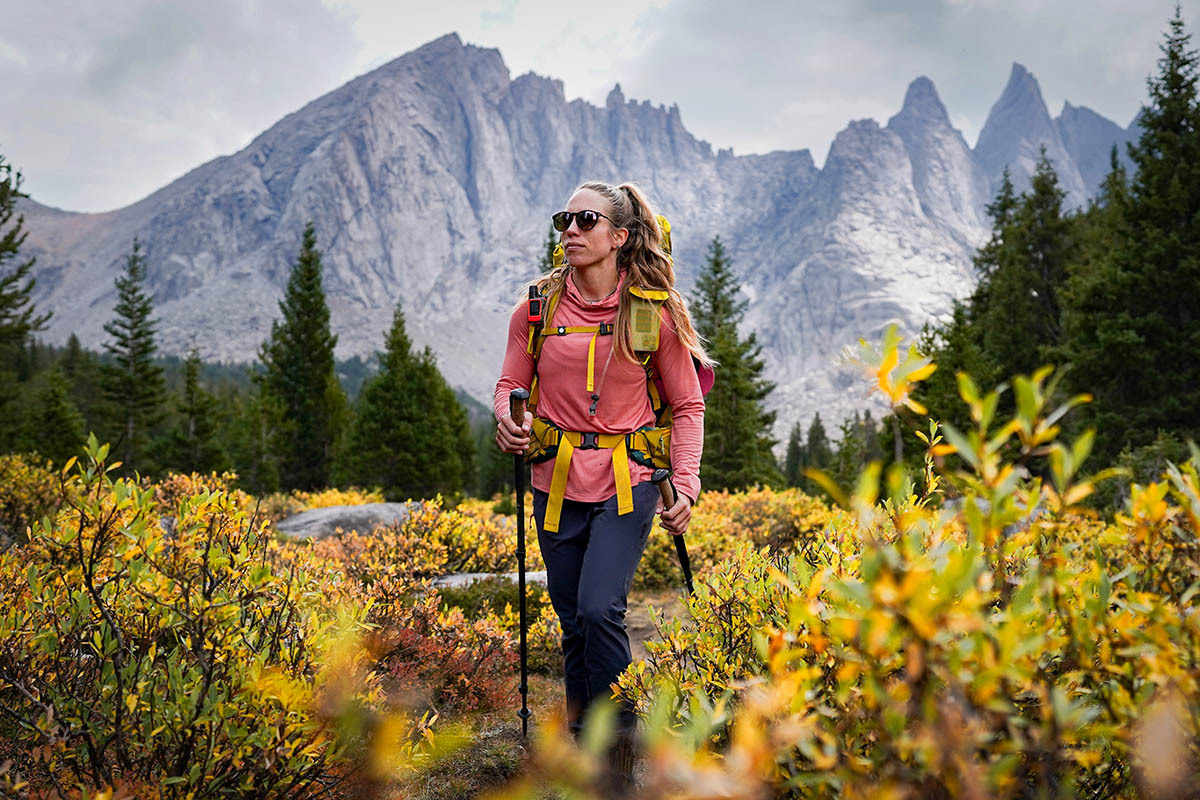
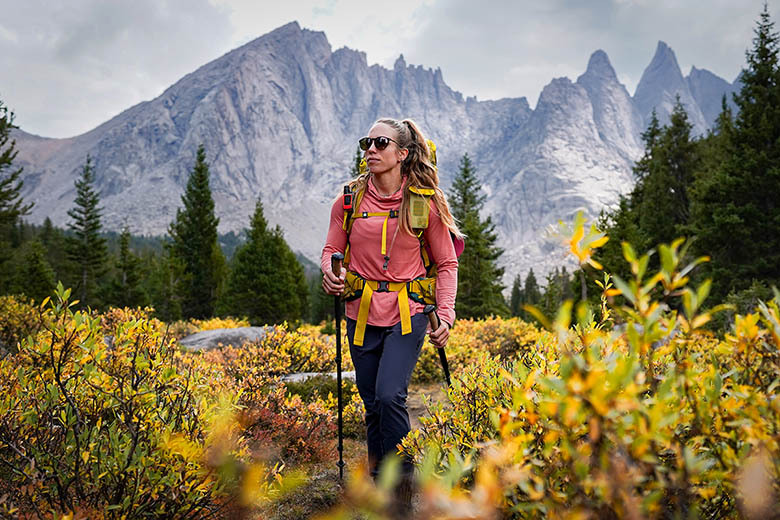
Chris Carter


Chris Carter
Move over sunburns, heat exhaustion, and sunscreen sweat—sun shirts are the newest solar antidote. With full upper-body coverage (our picks are all hooded), UPF ratings that ensure protection against both UVA and UVB rays, and breathable fabrics, sun shirts can keep you surprisingly cool and comfortable even on the warmest of days. We can’t live without our sun shirts for any activities that include a solar reflector, such as fishing (water), climbing (a rock face), or backcountry skiing (snow), and they’re equally practical for pursuits like stand up paddle boarding, hiking, and running. We’ve been testing these versatile pieces since late 2022, and below are our 17 current favorites, which cover a wide range of activities and conditions. For more background information, see our comparison table and buying advice below the picks, along with details about our testing process.
Editor’s note: We updated this guide on January 24, 2025, to remove a couple discontinued sun hoodies from Rabbit and Outdoor Research. We also revamped our coverage on several shirts and incorporated photos from a recent backpacking trip in Wyoming’s Wind River Range.
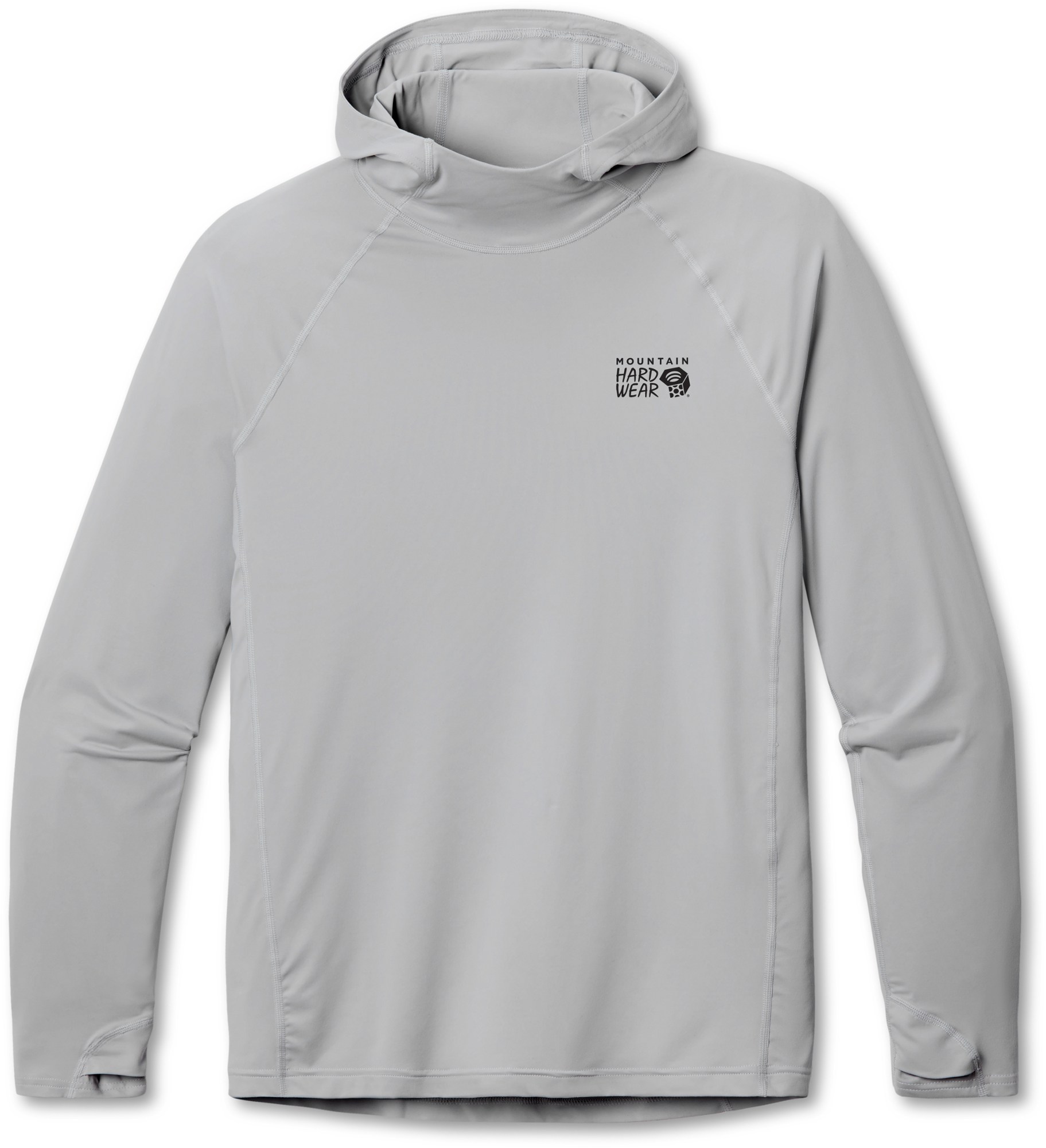 UPF: 50+
UPF: 50+
Materials: 88% polyester, 12% elastane
Weight: 4.2 oz.
What we like: Buttery soft and stretchy fabric; highly protective feature set.
What we don’t: Some might want a thinner, looser-fitting, or better-ventilated shirt.
Selecting our top pick is never easy, but Mountain Hardwear’s Crater Lake Hoody puts it all together with a class-leading combination of value, performance, and style. Next to the price (very reasonable at just $72), our favorite thing about the Crater Lake is the fabric, which is buttery soft and extremely comfortable against the skin. And although it fits fairly snugly (particularly around our arms), the polyester and elastane blend has a just-right amount of stretch and offers a cooling effect that we just can’t get enough of. Tack on a helmet-compatible hood, thumb loops, and unique men’s and women’s styles, and the Crater Lake was an obvious choice for our favorite sun hoody of the year.
But while we’re big fans of the Mountain Hardwear Crater Lake Hoody, some will benefit from a more purpose-built design. Most significantly, hikers or those prone to building a sweat might want a thinner, looser-fitting, or better-ventilated shirt like the Outdoor Research Echo below. We’ve found the lighter colorways perfectly serviceable for warm-weather hiking, but those who run warm may be underwhelmed by breathability and odor resistance. And for climbing, we don’t love the women’s version, which features a hem drawcord and zippered pocket that add bulk and don’t pair well with a backpack hipbelt or climbing harness. But it’s hard to argue with the Mountain Hardwear's balance of comfort, features, and protection (its UPF rating of 50+ is the highest given), earning it our top spot for this season.
Read more: Mountain Hardwear Crater Lake Hoody review
See the Men's MH Crater Lake Hoody See the Women's MH Crater Lake Hoody
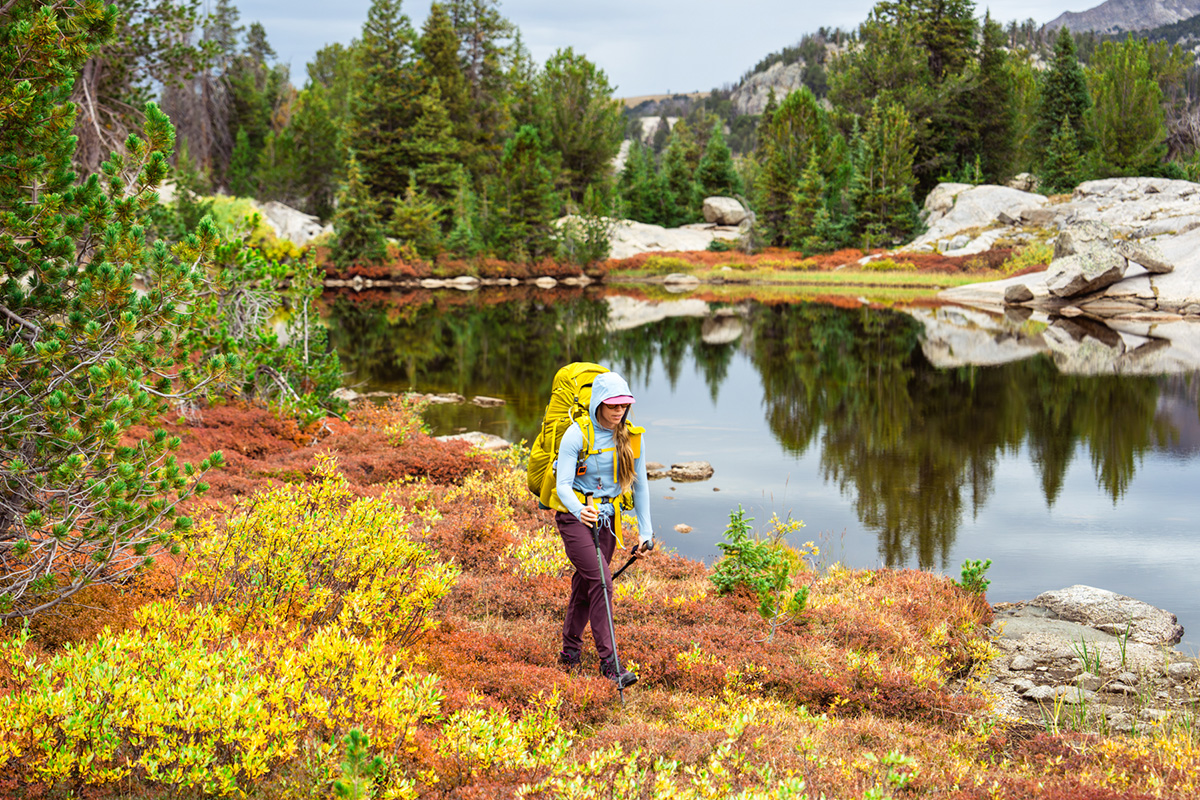
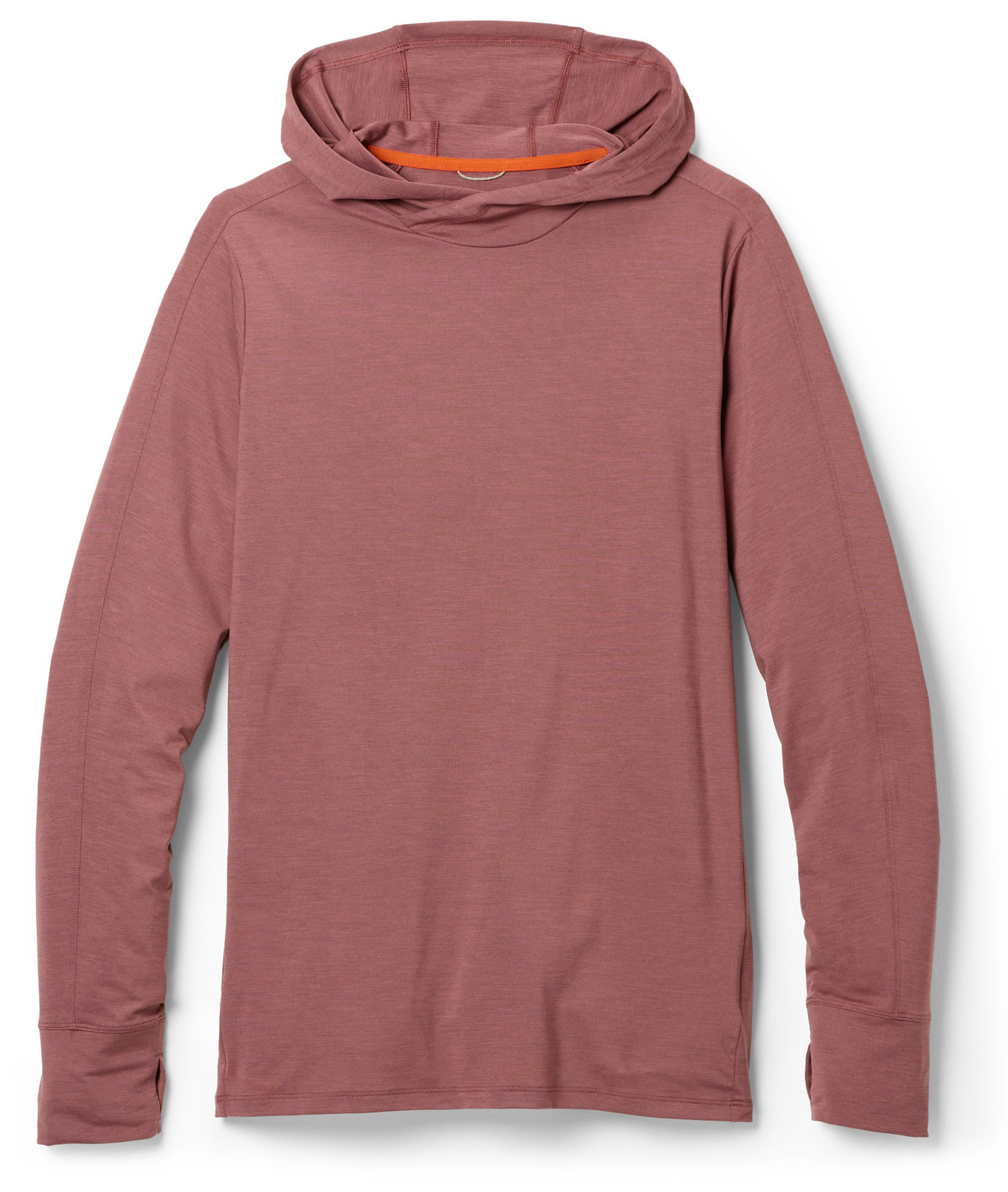 UPF: 50+
UPF: 50+
Materials: 92% polyester, 8% spandex
Weight: 8.8 oz.
What we like: Extremely comfortable and affordable; hidden hood cinch.
What we don’t: Scoop hem on women’s version isn’t ideal for wearing under a harness or hipbelt.
Sun shirts aren’t a particularly expensive purchase (our top pick is just $70), but hey, it’s 2025—every penny counts. If you’re looking to save, REI’s Sahara Shade Hoodie is one of the lowest-priced options here and particularly high on value. The bluesign-approved (read: sustainably sourced) polyester and spandex blend is super soft and stretchy, even after multiple washings, and it has a bit of the natural cooling effect we love. What’s more, the hood design is one of the best we’ve seen, with a hidden cinch that stays out of the way but still allows you to batten down the hatches in windy conditions. Tack on an effective antimicrobial treatment and low-profile thumbholes, and REI’s sun hoody is an excellent choice for low-output and mild-weather hiking.
Compared to thinner shirts like the Outdoor Research Echo below, the Sahara Shade traps a bit more heat and doesn’t dry as quickly. As a result, it’s not in our rotation for fast-paced activities like running or speedy hiking, nor do we choose it for most days on the water (unless we want the cooling effect of a wet shirt). But the flip side to the tight weave is excellent UV resistance, and we’re big fans of the Sahara’s aesthetic, which is calm, cool, and relaxed. On that note, the women’s version does have a stylish scoop hem, which we’ve found to be flattering but not the best pairing with a backpack or climbing harness. All told, the Sahara Shade is a nicely casual, well-rounded, and affordable sun protection shirt—and it doesn’t hurt that it’s available in a wide range of sizes, including men’s tall and women’s plus options.
See the Men's REI Sahara Shade Hoodie See the Women's REI Sahara Shade Hoodie
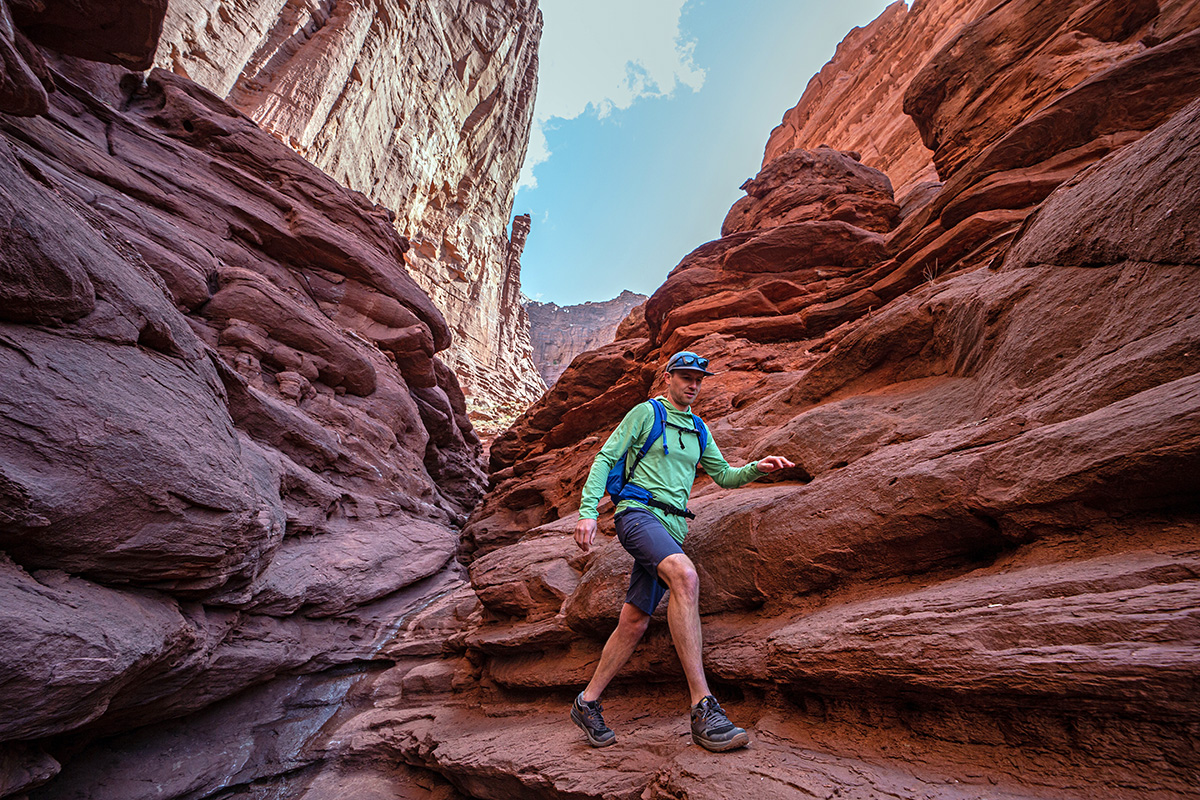
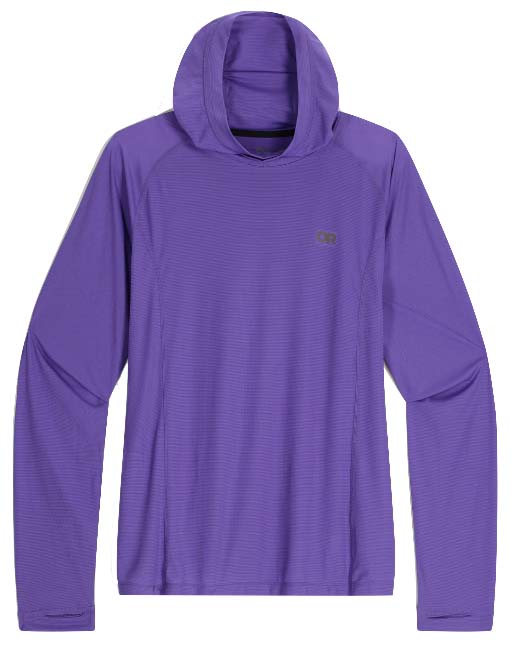 UPF: 15/20
UPF: 15/20
Material: 100% polyester
Weight: 5.2 oz.
What we like: Lightweight and breathable; lots of sizes and colorway options.
What we don’t: Fabric is prone to pilling and snagging.
Many sun shirts here are versatile enough to wear year-round for everything from hiking to skiing, but for true heart-of-summer use, we turn to light and airy designs like Outdoor Research’s Echo Hoodie. At just over 5 ounces and featuring an incredibly thin, 100% polyester build, the Echo breathes and wicks moisture better than most of the competition, making it an obvious choice for sweat-inducing activities like hiking, biking, or even running. You also get good odor control by way of OR’s ActiveFresh treatment, which we’ve found to be surprisingly effective. And with availability in six sizes for men and 10 for women (including plus sizes from 1X to 4X), along with plenty of colorways and patterns to choose from, there’s likely an Echo for you.
The Echo is one of our go-to sun shirts for summer hiking and water sports, but it does have a few shortcomings. While lightweight, the fabric is far from our favorite: It’s prone to pilling and snagging and lacks the soft next-to-skin feel of offerings like the Crater Lake and REI Sahara Shade above. Speaking of the Crater Lake, that hoody technically gets the edge in weight by an ounce, although we’ve found the OR’s fabric to be more porous, and the looser cut helps keep air moving. The Echo also has a relatively low UPF rating—20 for the darker colorways and 15 for the lighter options—which again falls short of the Crater Lake, which boasts UPF 50+ coverage. But 95% sun protection is better than 0%, which is what you’ll get when your thicker sun hoody heats up too much to handle. All told, for a simple and breathable sun shirt for hot conditions, the OR is hard to beat.
See the Men's OR Echo Hoodie See the Women's OR Echo Hoodie
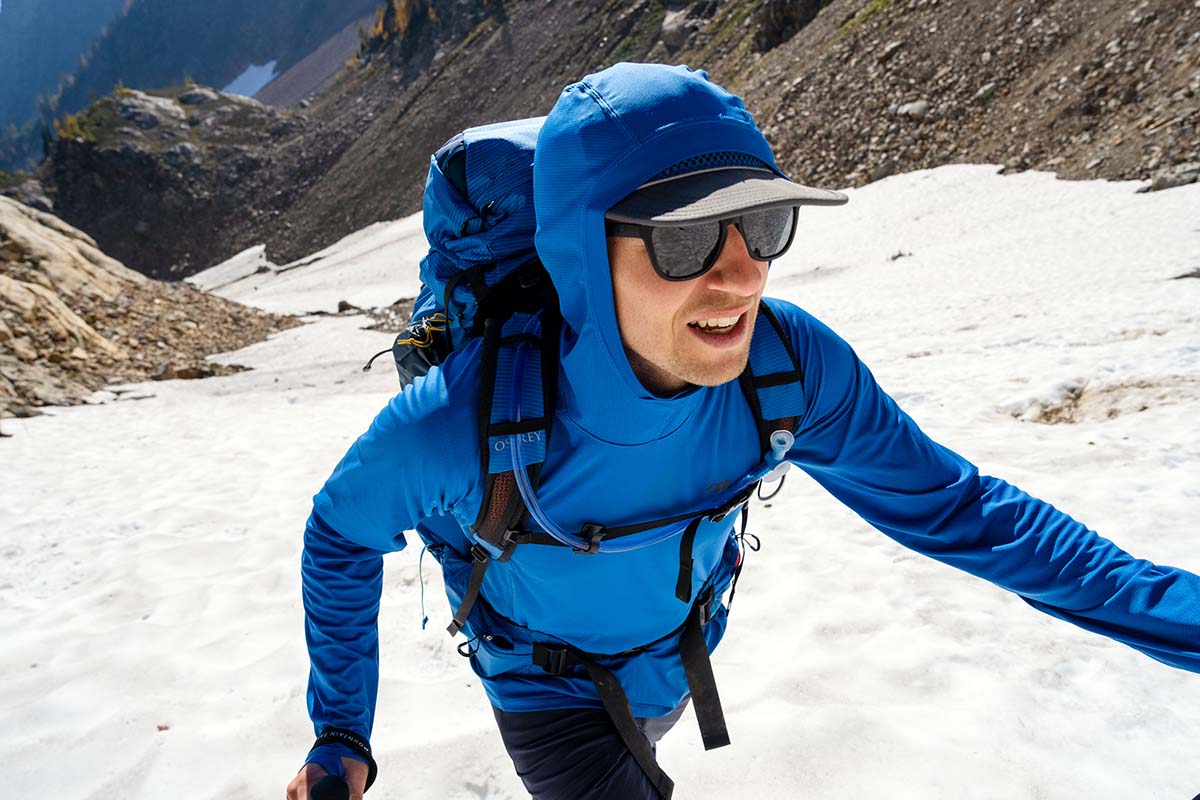
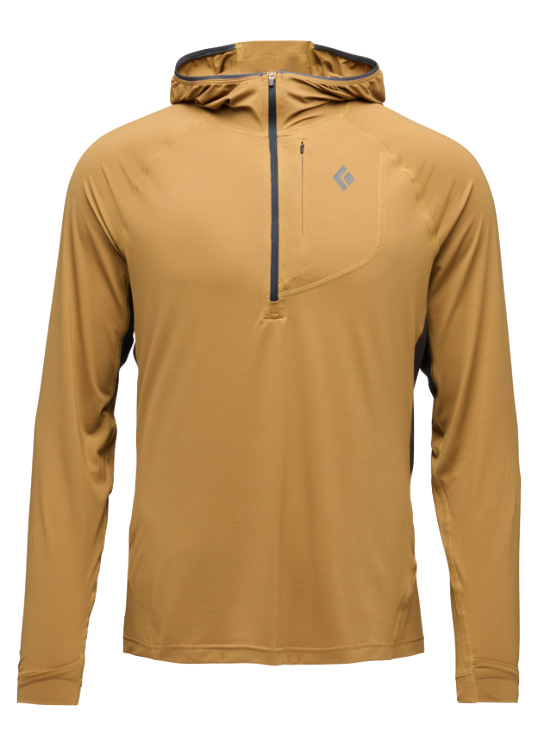 UPF: 50+
UPF: 50+
Materials: 92% nylon, 8% elastane
Weight: 8.0 oz.
What we like: Added durability and features for life in the vertical world.
What we don’t: Pricey and overbuilt for most.
Sun hoodies have long been popular among climbers, as almost nothing intensifies the sun’s rays like a sheer rock face. And while any shirt here will do, there are some additional details that prove to be very beneficial when climbing, such as extra-durable (but still incredibly soft) materials, zippered pockets, a hood that can slide over a helmet, and added ventilation. Black Diamond’s Alpenglow Pro checks all of those boxes and then some, making it a runaway choice for our favorite climbing-centric design. And while most sun shirts use polyester, the Alpenglow Pro is built with a stretchy, highly mobile nylon (treated with a PFAS-free DWR finish) for better abrasion and moisture resistance.
It’s true that the Alpenglow Pro is pricey at $129, and the rock-ready feature set will be overkill for most. But for the monkeys among us, it’s the real deal: We’ve worn the Black Diamond for 2+ years of heavy use, and it’s held up incredibly well with only minor piling at the waist from our harness/hipbelt. We also love the 1/4-length zipper for dumping heat on hot summer granite, and the underarm mesh panels (treated with HeiQ Pure for odor resistance) are a really nice bonus that most sun shirts lack. Finally, it’s worth noting that despite sharing the same name as the Alpenglow Pro, BD’s standard Alpenglow Hoody has a noticeably cheaper and more abrasive feel and lacks the features, breathability, and durability that make the Pro our top climbing pick.
See the Men's Black Diamond Alpenglow Pro See the Women's BD Alpenglow Pro

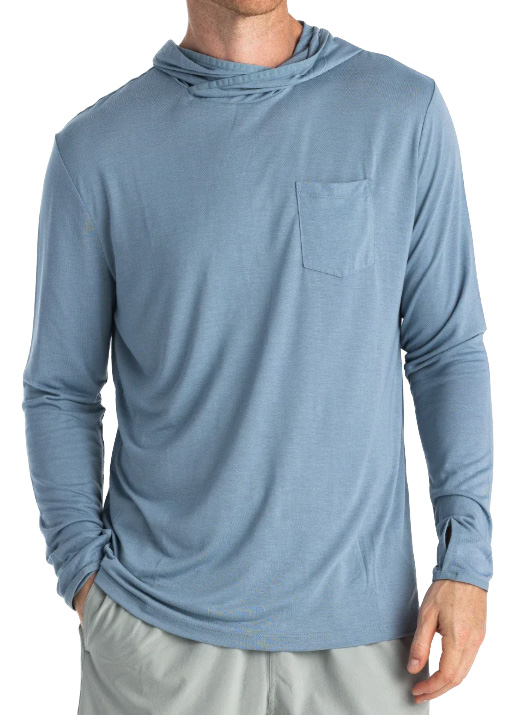 UPF: 20+
UPF: 20+
Materials: 70% viscose from bamboo, 30% polyester
What we like: Natural fibers lend an incredibly soft feel and great breathability.
What we don’t: Requires special care; bamboo does not wick moisture as well as synthetics.
If you’re looking for something a little different from the norm, the Free Fly Bamboo Lightweight Hoodie is a good place to start. Using a unique blend of polyester and viscose from bamboo, the Free Fly is one of the softest options here—akin to your favorite cotton t-shirt. And just like cotton, it breathes well and is naturally odor-resistant, too. Feature-wise, the Bamboo Lightweight sticks to a fairly standard but functional formula, including a deep hood and thumbholes, and we love the appropriately earthy vibe (it's currently available in seven classy colorways plus a “Vintage Camo” pattern). Added up, the bamboo Free Fly is a really nice alternative to the standard synthetic sun shirt, whether you’re getting out on water or dry land.
But as much as we love the feel (and sustainability) of natural materials, they do come with their downsides. Despite being blended with polyester, the Free Fly’s bamboo material is prone to shrinking, requires special care when laundering, and lacks the abrasion resistance of synthetics (climbers will want to look elsewhere). It’s also worth noting that bamboo is similar to cotton in terms of its absorptive qualities: The Free Fly does not shed moisture well or dry particularly quickly. For the right user, this will provide an extra cooling effect on hot days; others will want to prioritize a better-wicking design. Finally, the popular Lightweight Hoodie has a relatively low UPF rating of 20+ (keep in mind, this still keeps out 95% of the sun’s rays), but Free Fly also makes their slightly thicker Bamboo Shade Hoody ($80) with a UPF rating of 50+.
Read more: Free Fly Bamboo Lightweight II review (women's version)
See the Men's Free Fly Bamboo Lightweight See the Women's Bamboo Lightweight II
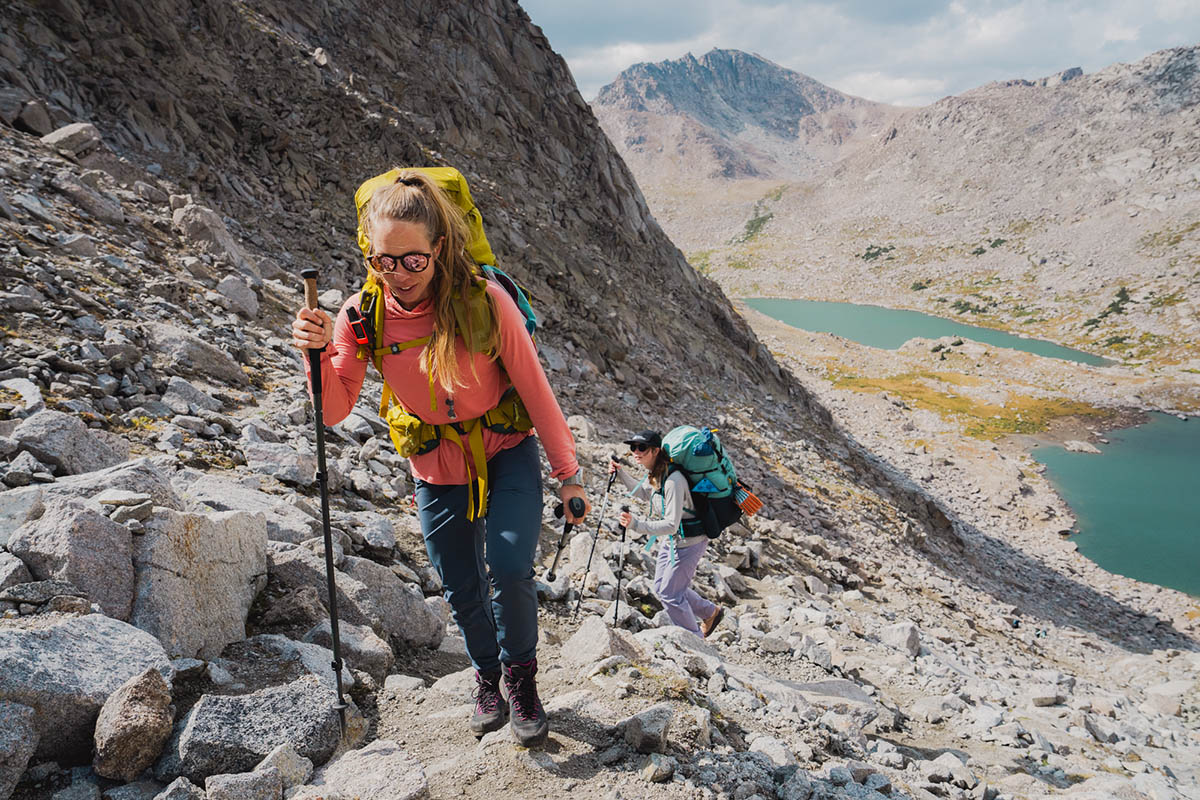
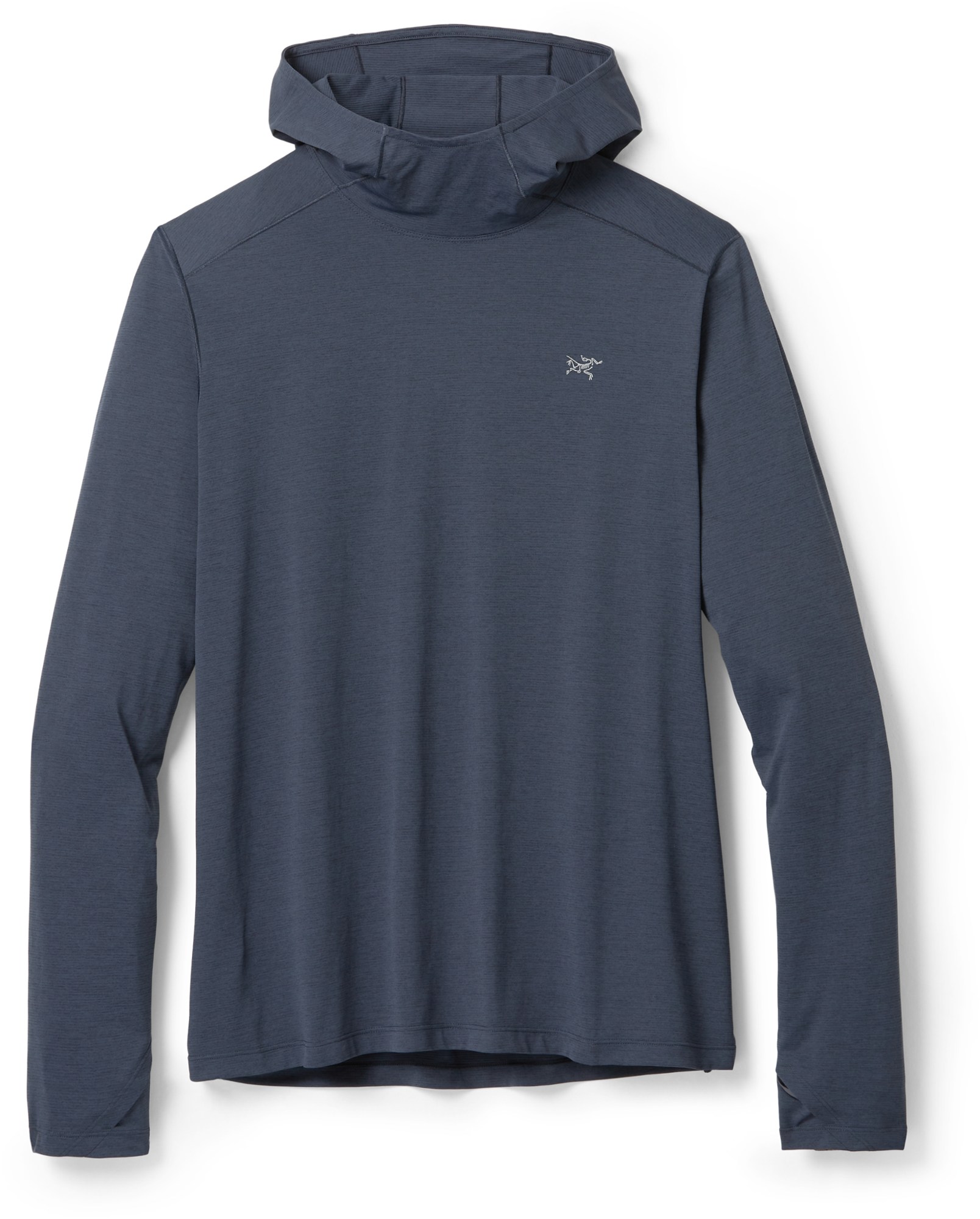 UPF: 40+
UPF: 40+
Material: 100% polyester
Weight: 5.6 oz.
What we like: Soft, breathable, quick to dry, and has the premium feel we’ve come to expect from Arc’teryx.
What we don’t: Hood works best with a helmet or ball cap underneath; fabric is prone to sagging at the waist.
Arc’teryx’s offerings are consistently premium in both feel and performance, and the Cormac (and women’s Taema) is no exception. Like the OR Echo above, the Cormac is a lightweight sun shirt ideal for hot conditions, with a 100%-polyester Phasic LT fabric that’s thin, wicks moisture well, and is quick to dry. But unlike paper-thin shirts like the Echo above, the Arc’teryx is also surprisingly cozy and soft next to the skin. Most of the details are equally well sorted, including low-profile seams, a hood that pairs nicely over a helmet, a high collar for maximizing coverage, and effective water-resistant and anti-odor treatments. As a result, it’s one of the first sun shirts we reach for whether we’re backpacking, backcountry skiing, paddle boarding, or climbing.
Unfortunately, we came away with some small gripes in testing. First, while the Cormac's hood functions flawlessly when worn over a helmet or ball cap, we found it to be very floppy on its own, extending over our forehead and impeding our vision on several occasions. The Cormac’s fabric is also a bit prone to sagging, especially around the waist, which helps keep air moving but can fold and pinch underneath a harness. Finally, the thumb loops have a somewhat rigid strip of fabric on the interior separating the thump and pointer finger, which led to visible irritation after a day and a half of continued wear (to be fair, we were climbing during that time, which put more pressure on that area). Overall, we think Arc’teryx nailed most of the core details—including excellent comfort, breathability, and moisture-wicking capabilities—earning the Cormac a respectable finish on our list this season. Of note: The women's version has a much thinner thumb loop without any extra material. It also runs on the small side, so we recommend sizing up for a flowier fit.
See the Men's Arc'teryx Cormac Hoody See the Women's Arc'teryx Taema Hoody
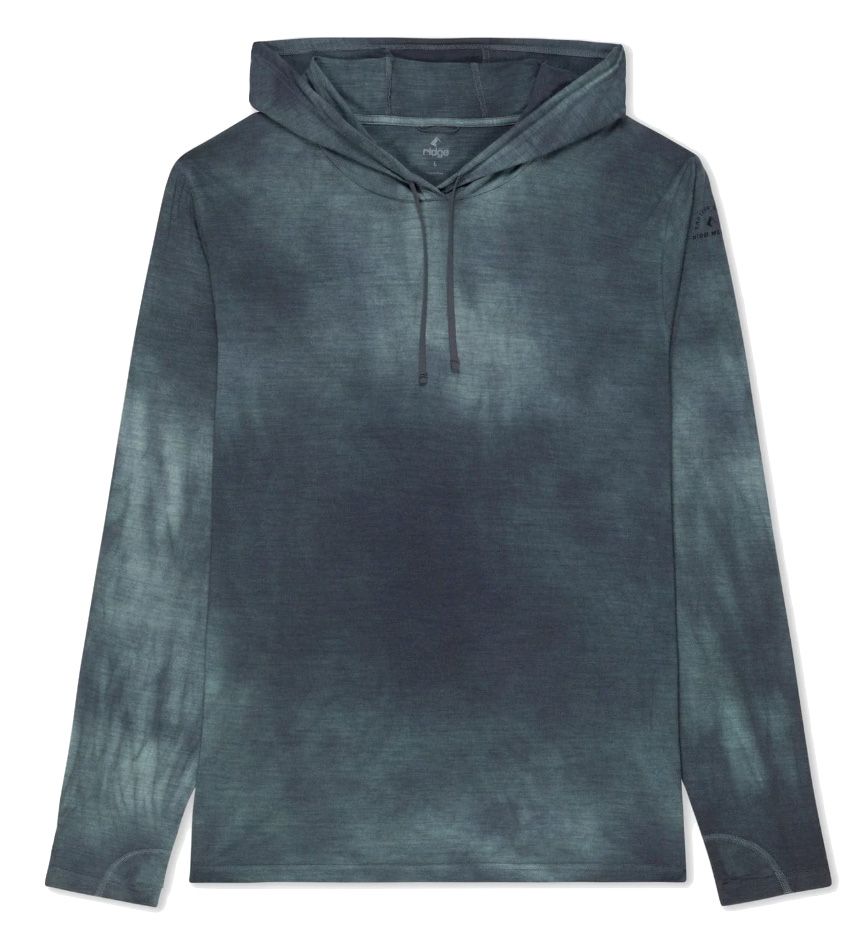 UPF: 30+
UPF: 30+
Materials: 87% merino wool, 13% nylon
Weight: 8.7 oz.
What we like: The coverage of a sun shirt with the added benefits of merino wool.
What we don’t: Too warm for most conditions.
The vast majority of sun shirts are built with lightweight synthetic materials, which offer long-sleeve protection but provide minimal warmth. That said, for cold-weather activities like snowshoeing or backcountry skiing, a merino wool sun shirt can provide a nice boost in insulation. Our favorite design in this category is the Ridge Merino Solstice Lightweight Pullover Hoodie, which toes the line between the baselayer and sun hoody categories for those days when you need a little bit of both (keep in mind, the sun can be extra intense when reflecting off of snow). Another bonus: Ridge Merino is known for their high-quality yet affordable merino wool designs (their Aspect line is one of our favorite midweight baselayers), and the Solstice is no exception at just $85.
The Solstice offers all of the benefits of merino wool, including excellent temperature regulation, supreme next-to-skin comfort, and better odor resistance than synthetics. But it’s the rest of the design that gets our critique: The hood is oversized, the long drawcord gets in the way, and the fit is very roomy (you’ll likely want to size down). And given its merino build, the Solstice is not all that versatile—we’ve overheated quickly in mild conditions and when working moderately hard. Most backcountry skiers we know just wear their standard synthetic sun hoody, but for merino lovers looking for a purpose-built hybrid, the Ridge Merino is a premium option. And if you’re intrigued by the wool build but looking for something a little different, check out Zpacks’ The Mirage below.
See the Men's Ridge Merino Solstice See the Women's Ridge Merino Solstice
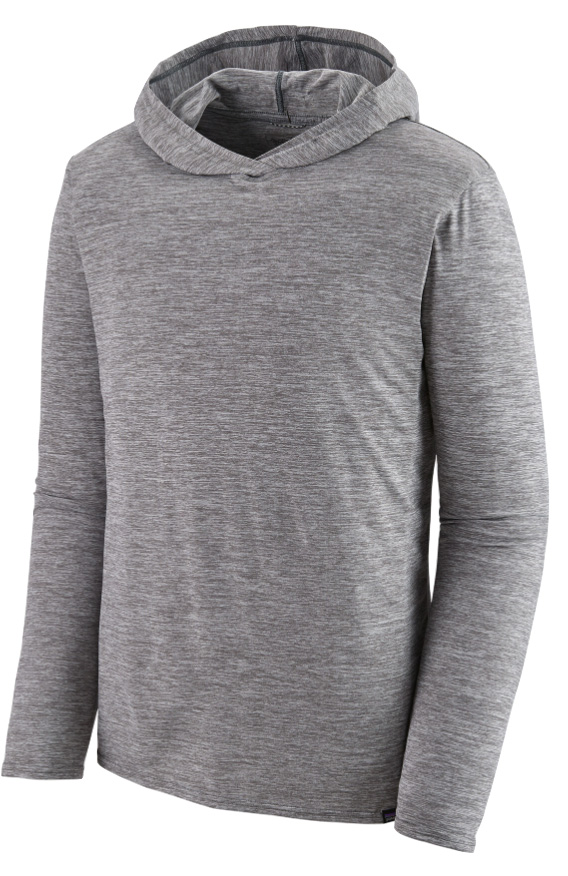 UPF: 17-45
UPF: 17-45
Material: 100% polyester jersey
Weight: 6.3 oz.
What we like: A breezy, quick-drying design at an affordable price point.
What we don’t: Lacks durability and features.
Patagonia’s Capilene Cool Daily is one of the most popular sun shirts on the market, so it’s a bit of a surprise to see it mid-pack on our list. Don’t get us wrong—this layer certainly gets the job done. Its fabric is lightweight and free-flowing, includes a bit of stretch for freedom of movement, and has more of a cooling effect than many other sun shirts we’ve tested. What’s more, it keeps its shape well when wet, is quick to dry, and doesn’t hold a stink like a lot of synthetics, either (thanks to the HeiQ Pure treatment). Added up, the Capilene Cool Daily is a simple yet effective sun shirt for everything from trail to water.
But Patagonia's popular sun shirt falls short in a few ways. For one, it lacks thumbholes, which can be a particularly nice feature for bikers (eliminating the gap between the gloves and sleeves). Second, the thin fabric won’t hold up to repeated contact with rock as well as nylon or a polyester-spandex blend (we’re talking to you, climbers). And finally, the fit leaves a lot to be desired: Many have found that the Capilene runs short both at the hem and the arms, and the hood is annoyingly shallow. But for affordable all-around sun protection, the Patagonia gets the job done for most, and we love the company’s transparency around its UPF rating, which falls between 17 and 45 (as they state, even at 17, it blocks 92% of the sun’s rays).
See the Men's Patagonia Capilene Cool Daily See the Women's Patagonia Capilene Cool Daily
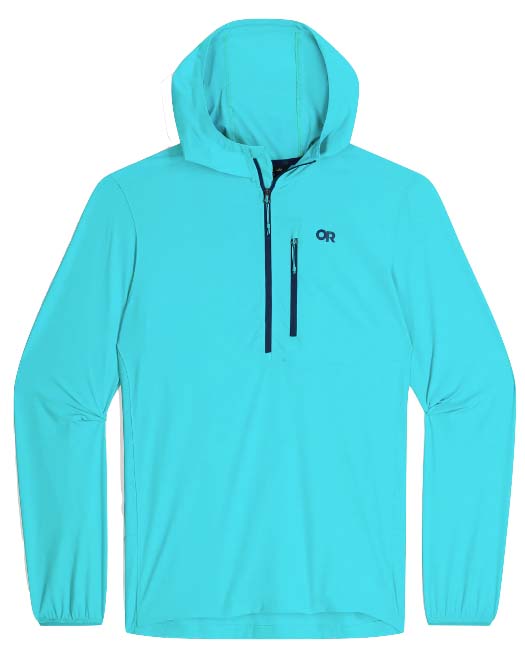 UPF: 30/50+
UPF: 30/50+
Materials: 85% nylon, 15% spandex
Weight: 5.6 oz.
What we like: Great climbing-specific feature set.
What we don’t: Not particularly soft or supple; lacks breathability.
The Black Diamond Alpenglow Pro above is our favorite climbing-specific sun shirt, but OR’s Astroman Air Sun Hoodie isn’t too far behind. Interestingly, the Astroman shares many of the same features as our favorite wind shirts, including a deep front zipper, a zippered chest pocket (this pocket is near the hip on the women’s version), and elastic cuffs that won’t get in the way of your hand jam. We also appreciate the laser-perforated holes along the underarms and sides, which work similarly to the mesh panels on the Alpenglow Pro for dumping excess heat. To top it off, the OR features a nicely sized hood that can be worn on its own or stretched over a low-profile climbing helmet.
That said, the Astroman falls short of the Alpenglow Pro in a few ways. While the OR’s fabric has a really nice stretch to it, it lacks the super-soft and supple feel of the Black Diamond, which is a lot more comfortable when worn over a tank top or bare skin. The Astroman is also significantly less breathable than the Alpenglow Pro—the trade-off is a more substantial and confidence-inspiring feel around sharp rock—and the women’s pocket has an odd placement that lies just underneath a harness. But for $21 and 3 ounces less, it’s an affordable and functional sun shirt for climbers and mountaineers.
See the Men's OR Astroman Air Sun Hoodie See the Women's OR Astroman Air Sun Hoodie
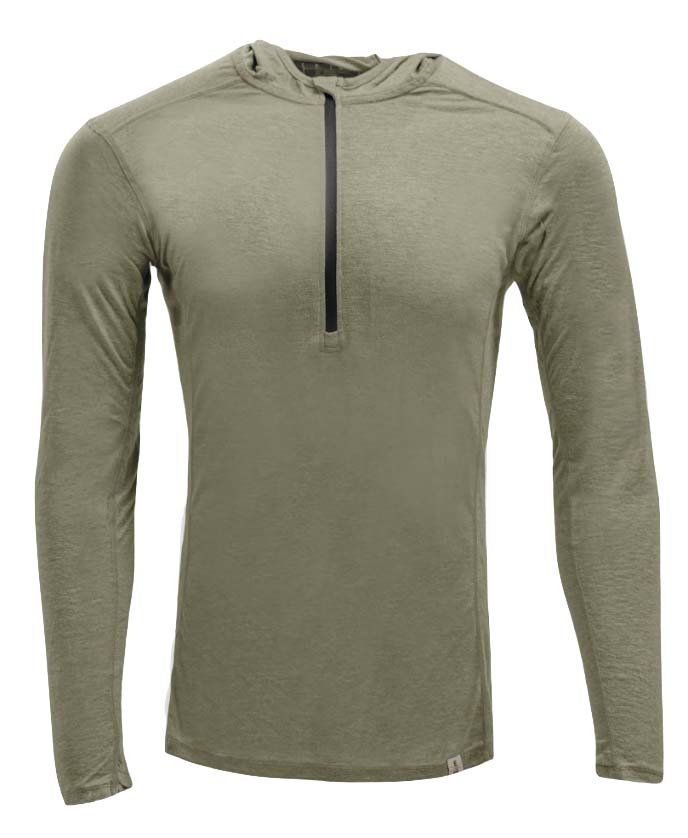 UPF: 40+
UPF: 40+
Materials: 96% merino wool, 4% spandex
Weight: 8.2 oz.
What we like: Impressively resistant to stink and abrasion; quarter zip makes it easy to regulate temperature.
What we don’t: Prone to pilling and not the best option for mid-summer use.
Joining Ridge Merino’s Solstice Lightweight Hoody above is another wool favorite: Zpacks’ The Mirage. For $15 more than the Solstice, The Mirage uses a merino-heavier blend that really maximizes the natural moisture-wicking and odor-fighting abilities of wool. We were also pleasantly surprised by the hoody’s breathability and durability during a recent backpacking trip in Patagonia, where the Zpacks kept us comfortable in exposed, hot conditions and came away tear-free despite a considerable amount of bushwhacking through thick brush. It dried faster than expected for a merino layer too, and the quarter-zip design made for quick and easy ventilation on the trail. Taken together, it’s a surprisingly versatile and easy-to-wear piece that can pull double duty as a baselayer in the colder months (we recommend sizing down for a snug, athletic fit).
The Mirage is a little thinner than the Ridge Merino Solstice above (135g vs. 145g), although it still wouldn’t be our first choice for mid-summer temperatures—for that, we turn to superlight synthetics like the OR Echo above. We also found the thinner merino build prone to pilling—our hoody started to show wear around the wrists first, and then throughout the arms—although most synthetics would have suffered some sort of damage from the aforementioned bushwhacking. And at $100, you’re paying a bit of a premium for the Zpacks name and specialty build, especially considering The Mirage forgoes pockets. But we’ll leave you with this: We rarely took the hoody off during our two-week trip to Patagonia, and it’s earned a spot front and center in our closet for upcoming hiking and backpacking adventures.
See the Zpacks The Mirage Merino Sun Hoody
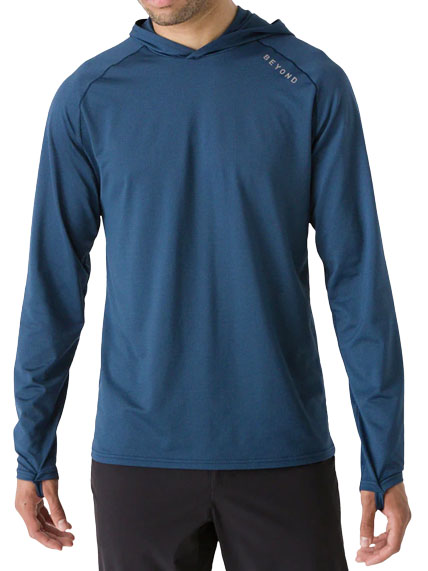 UPF: 50
UPF: 50
Materials: 92% polyester, 8% elastane
Weight: 8.2 oz.
What we like: Honeycomb knit fabric offers a durable yet breathable alternative to silky sun-shirt designs.
What we don’t: Only comes in three darker colorways.
Beyond Clothing got their start providing outdoor apparel for the U.S. military, but they’ve since expanded their offerings to the general public. The newly released Geo-T Hooded offers a different feel from silky sun shirts like the Crater Lake and Capilene Cool Daily with its textured, honeycomb knit fabric. You don’t get the same “active cooling” effect of the soft and stretchy designs we’ve come to love, but the Geo-T’s unique construction nevertheless breathes well and has held up nicely to heavy use. And as a bonus, Beyond incorporates Ionic+ Odor Control, which weaves antimicrobial silver ions into the fabric for odor resistance—great for those who anticipate wearing the shirt for multiple days between washings.
But aside from the innovative material and helpful antimicrobial treatment, there’s nothing particularly special about the design. Like most sun hoodies, the Geo-T’s hood is fairly roomy and gets blown off in direct gusts, and we had to size down for a better fit (sun shirts are notoriously roomy, but we don’t love the oversized look and feel for applications like hiking and trail running). And although we do like the three classy colorways, we wish the Geo-T came in some lighter shades for better heat deflection. These gripes aside, Beyond’s sun protection shirt is a nice and airy change of pace from standard designs, earning it a spot on our list.
See the Men's Beyond Geo-T Hooded See the Women's Beyond Geo-T Hooded
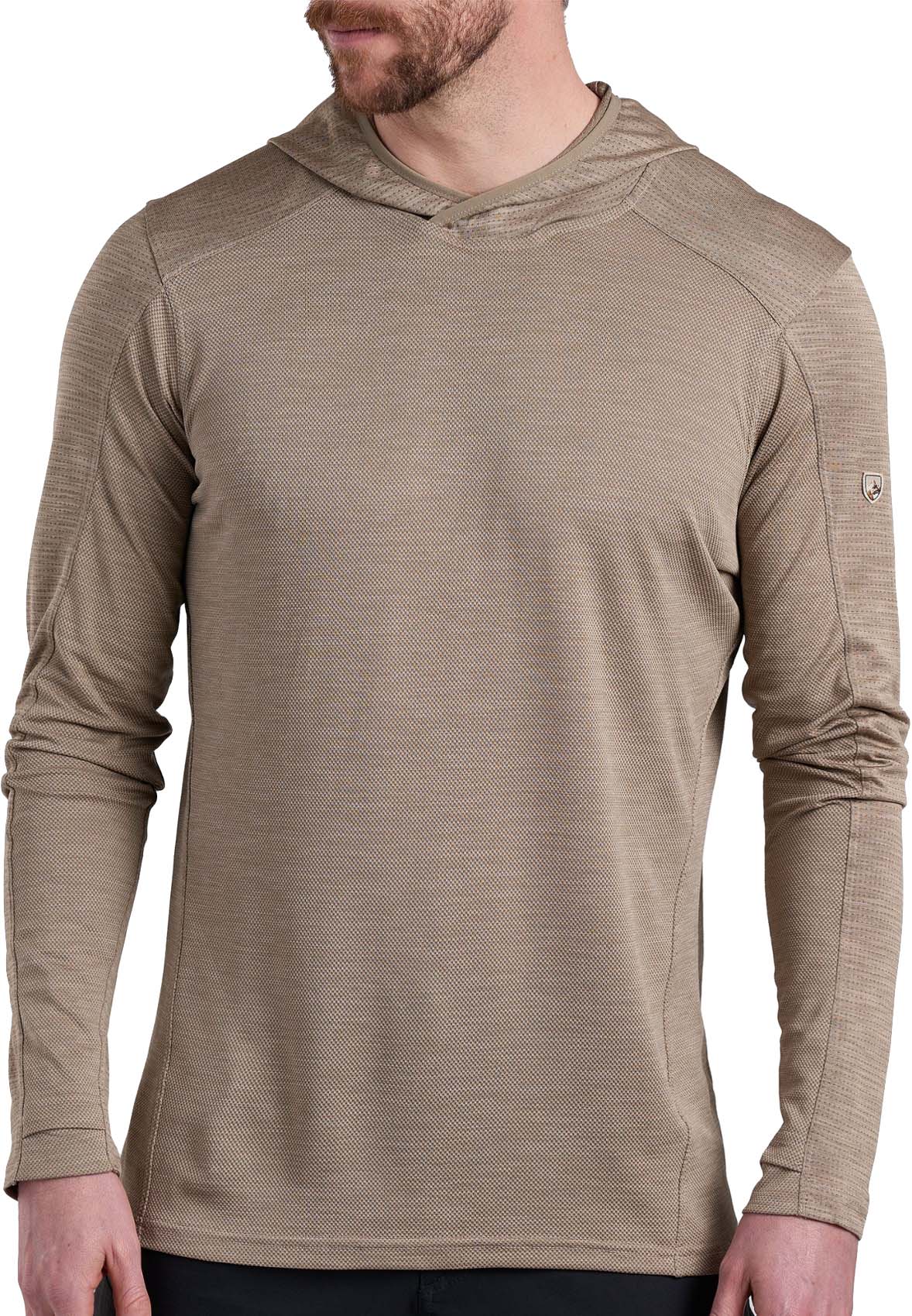 UPF: 20+/30+
UPF: 20+/30+
Material: 100% polyester
Weight: 8.0 oz.
What we like: Eye-catching and functional two-toned design.
What we don’t: Runs warm and relatively low UPF rating.
Kühl’s offerings typically strike a nice balance between casual style and technical savvy, and their Engineered Hoody is a case in point. This eye-catching sun shirt combines two fabric thicknesses—140-gram polyester across the shoulders, sleeves, and hood and thinner 130-gram open-knit polyester along the torso—for a subtly two-toned style that maximizes protection where you need it with good breathability everywhere else. Tack on sleek thumb holes and an overlapping collar that minimizes restriction at the neck, and the Kühl Engineered is a functional and fashionable choice for laid-back outdoor outings in the sun.
The Kühl Engineered Hoody slides in toward the bottom of our list due to its slightly more casual intentions. The hoody only comes in a couple light colorways (the rest are decidedly dark) and is a bit thicker than we’d prefer for most uses. And given the fabric weight and tone—plus the $85 price tag—the UPF ratings are rather disappointing. Finally, while we like the look of the seam that runs across the upper chest and down the arms, it could prove to be uncomfortable, especially for activities like surfing. In the end, there’s no shortage of more performance-oriented shirts to choose from, but we understand the appeal of the Kühl for more casual use.
See the Men's Kühl Engineered Hoody
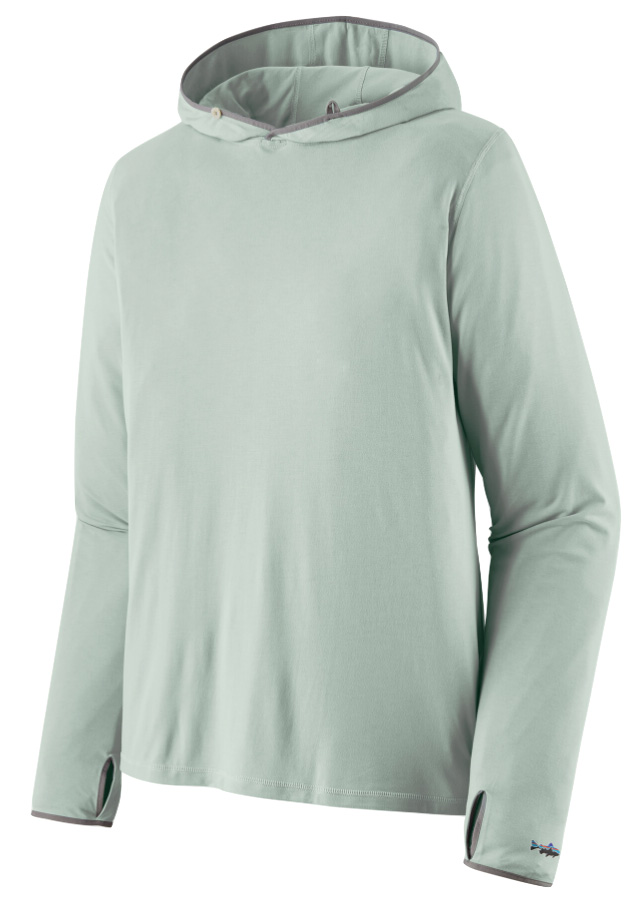 UPF: 40+
UPF: 40+
Materials: 96% modal, 4% spandex
Weight: 9.4 oz.
What we like: Natural fibers offer a soft and breathable feel.
What we don’t: Not particularly quick-drying or durable.
Patagonia’s Tropic Comfort Natural UPF Hoody offers a slightly different take on the sun hoody concept. Using Patagonia’s modal sun material (sourced from natural beech tree pulp), it has the soft feel of cotton, which is a nice change-up from more slippery synthetic alternatives. It also acts like cotton, meaning it’s fairly breathable, resists odors, absorbs moisture, and is fairly slow to dry. Finally, we’ve also found the Tropic Comfort Natural to be pretty wind-permeable—great news for staying cool. For everything from hiking and farming to super hot days by the river, it’s well worth a closer look.
Those who prefer to wear natural fibers will find the Patagonia rather appealing, but we're not sure it's worth the $30 price bump over the Free Fly above. Given its cotton-like material, you won’t want to opt for the Tropic Comfort Natural if having a wet shirt is a concern (it’s not an ideal choice for mountain missions where bad weather could swoop in), and durability is a step down from shirts like the Crater Lake and Cormac above. But for frontcountry use, the Tropic Comfort Natural is a really nice alternative to nylon and polyester designs. It’s also worth noting that the sizing is very generous (including long arms for back-of-hand coverage)—unless you’re looking for a roomy fit, you’ll want to size down.
See the Men's Patagonia Tropic Comfort See the Women's Patagonia Tropic Comfort
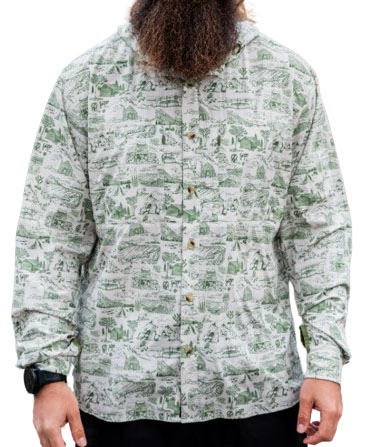 UPF: 30
UPF: 30
Materials: 86% polyester, 14% spandex
Weight: 8.5 oz.
What we like: Great ventilation for hikers (and others) working up a sweat.
What we don’t: Not everyone will love the thru-hiking personality.
The Triple Crown Button Down is Jolly Gear’s primary offering, and boy is it a good one. Designed and built by a thru-hiker named Jolly who knows firsthand the need for breathable sun protection, the Triple Crown Button Down combines the hood of a standard sun hoody with the button-up ventilation of a hiking shirt. And aside from the brilliant Frankensteined design, our favorite thing about the Triple Crown is the variety of fun patterns, all of which are built with stretchy, antimicrobial polyester. Finally, the shirt is made in both long- and short-sleeved versions, and Jolly Gear also offers sun sleeves (a $35 add-on) for those who choose the latter.
Standard sun shirts can get the job done for low-output activities like water sports, fishing, and climbing, but we often find ourselves overheating during hot days on the trail. And while button-up hiking shirts are a dime a dozen, the lack of a hood can be a real dealbreaker for some (ourselves included). For this reason, the Triple Crown Button Down is an outstanding design that deserves a place in every serious hiker’s arsenal—if you can handle its distinct thru-hiker personality and decidedly flashy looks.
See the Jolly Gear Triple Crown Button Down
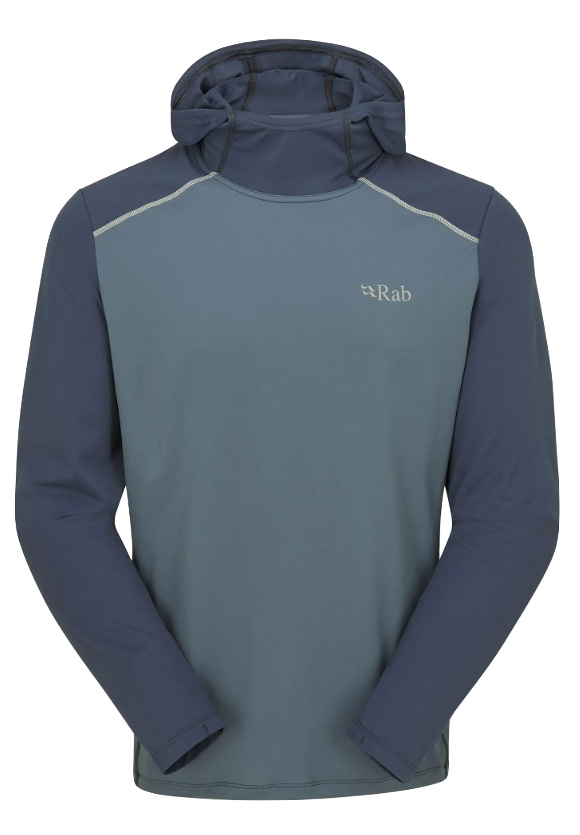 UPF: 35
UPF: 35
Material: 100% polyester
Weight: 5.8 oz.
What we like: Thin and breathable construction; rides comfortably under a pack with minimal pressure points.
What we don’t: Technical feel and less comfortable than most.
Rab’s Force Hoody doesn’t break any ground with its design, but it’s a lightweight and breathable sun shirt that won’t be too hot to handle on the trail. The 105-gram polyester is thinner than most shirts here (it feels reminiscent of the OR Echo), and Rab incorporated low-bulk and shifted seams (dropping them off the top of the shoulders and away from the true sides) to eliminate pressure points under a pack. Like most sun shirts here, you also get low-profile thumb loops, and the hood is fairly snug and meant to fit under a helmet.
We wore the Force during a three-day backpacking trip and came away with mixed reviews. While the thin fabric did an above-average job dumping heat (on par with the Arc’teryx Cormac and just slightly less breathable than the OR Echo above), we didn’t love the look and feel of it. Similar to the Echo, the Force has a very technical vibe that feels more akin to a lightweight baselayer than a sun shirt. And while Rab often appeals to the vertically oriented crowd, the Force’s simple design omits all the details we love in a climbing-specific layer. To be sure, it’s a quality pick that’s high on breathability, but there are plenty of more innovative (and comfortable) options to consider.
See the Men's Rab Force Hoody See the Women's Rab Force Hoody
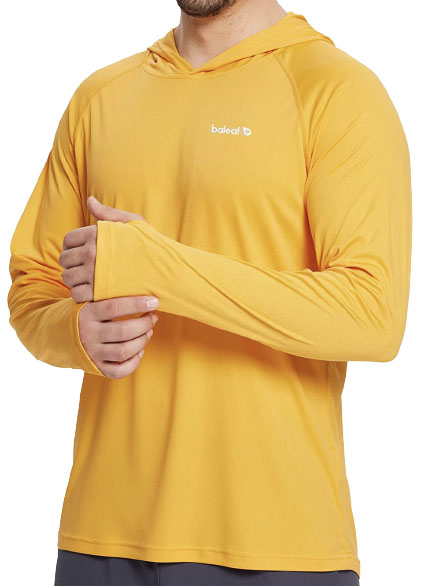 UPF: 50+
UPF: 50+
Material: 100% polyester
What we like: Long-lasting sun protection for just a little more than a bottle of sunscreen.
What we don’t: Runs warm and only available in men’s sizing.
If you’re looking to keep costs low or aren’t sure if a sun shirt is the right layer for you, it might be worth opting for a budget design like the Baleaf UPF50+ here. For just $24 (colorways vary slightly on Amazon), the UPF50+ Sun Hoodie offers as much protection as shirts four times its price, and it even includes premium touches like flatlock seams and a no-tag collar to minimize chafing. For affordable, no-frills UV protection, the Baleaf is an easy choice.
We’re big fans of the Baleaf for fairly low-output activities like fishing and river guiding, but it runs a bit warm for mid-summer use. The 100% polyester construction is on the thicker side and doesn’t breathe particularly well, and you don’t get any added ventilation measures like a zippered/buttoned collar or underarm mesh. What’s more, the hood is decently large and has no way of cinching down, so it’s prone to flying off in the wind or if you’re running. And finally, Baleaf doesn’t offer the shirt in a women’s version, which strikes us as a major oversight. But if the sizing works for you, it will cost you just a little more than a bottle of sunscreen (without the sticky residue). Now if only Baleaf made a coconut-scented sun hoody…
See the Baleaf UPF50+ Sun Hoodie
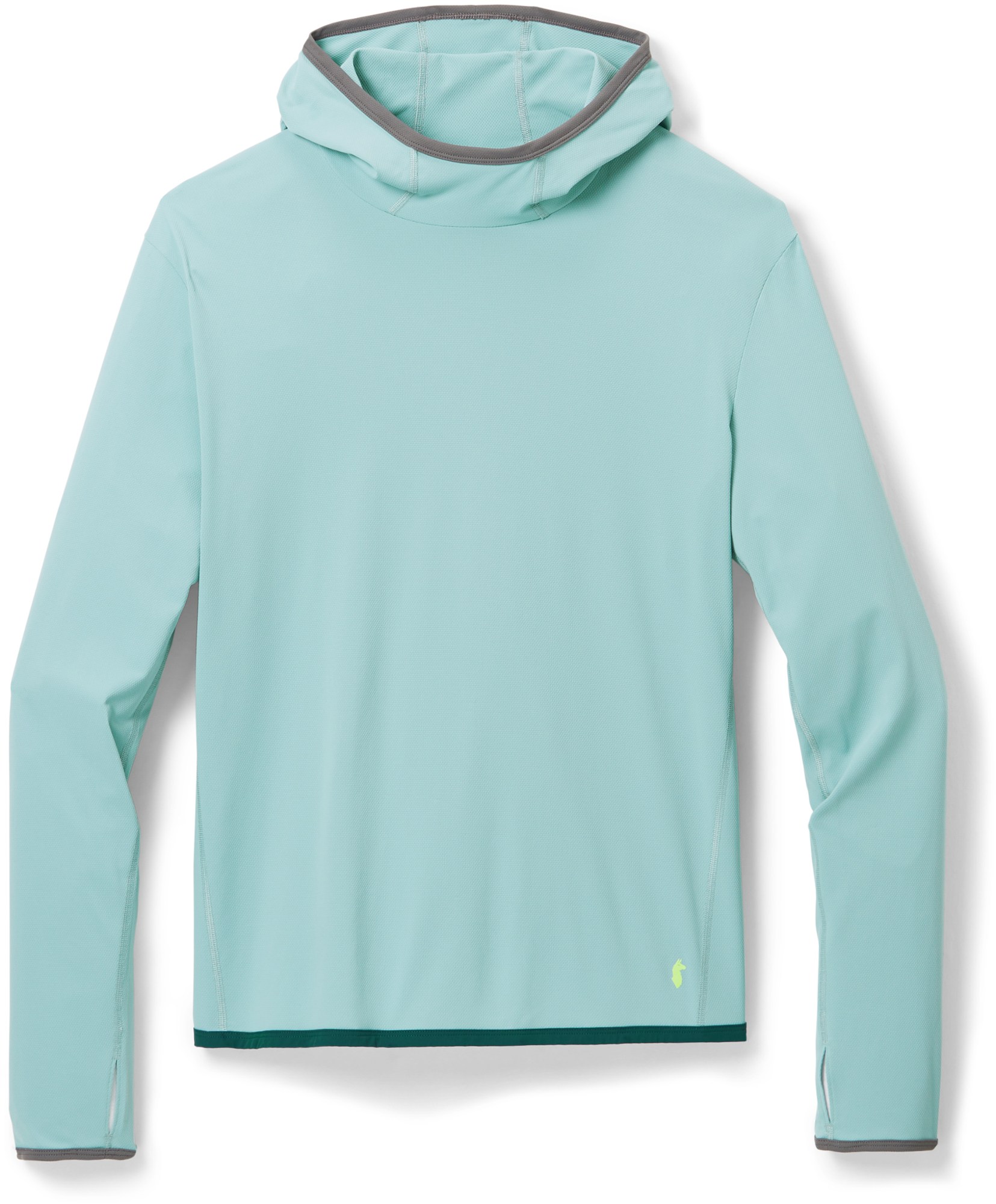 UPF: 50+
UPF: 50+
Materials: 100% polyester (pocket: 85% nylon, 15% spandex)
What we like: A fun and colorful sun hoody from an ethically minded company.
What we don’t: Low-quality fabrics and runs warm.
Based in Salt Lake City, Cotopaxi is a relatively new brand that has quickly risen to popularity in the outdoor world thanks to their sustainable business practices, positive community presence, and—of course—eye-catching colorways. The Sombra is their take on the classic sun hoody, featuring a double-layer construction that wicks moisture and offers the highest level of sun protection. Unlike most of Cotopaxi’s offerings, the Sombra is fairly subdued (the only color-blocking you get is a contrasting pocket and elastic binding), but the style nevertheless adds a bit of flair compared to most offerings here.
We really wanted to like the Cotopaxi Sombra, but there are a few key flaws with the design. First off, the fabric has a low-quality feel that’s noticeably prone to snagging and pilling and doesn’t hold up particularly well to laundering. It’s also very thick for a sun shirt, which results in a warmer experience than most hikers, bikers, and climbers will want. And we’d expect the Sombra’s saving grace to be its style, but it falls short in that department, too, with a fairly boxy fit and particularly short cut in the women’s version. For the price, there are a number of higher-quality options to choose from, pushing the Sombra to the bottom of our list.
See the Men's Cotopaxi Sombra See the Women's Cotopaxi Sombra
| Sun Shirt | Price | UPF | Materials | Weight | GSM* |
|---|---|---|---|---|---|
| Mountain Hardwear Crater Lake Hoody | $72 | 50+ | 88% polyester, 12% elastane | 4.2 oz. | 120 |
| REI Co-op Sahara Shade Hoodie | $50 | 50+ | 92% polyester/8% spandex | 8.8 oz. | Unavail. |
| Outdoor Research Echo Hoodie | $75 | 15/20 | 100% polyester | 5.2 oz. | Unavail. |
| Black Diamond Alpenglow Pro Hoody | $129 | 50+ | 92% nylon, 8% elastane | 8.0 oz. | 158 |
| Free Fly Bamboo Lightweight Hoodie | $68 | 20+ | 70% bamboo, 30% polyester | Unavail. | 140 |
| Arc’teryx Cormac Hoody | $90 | 40+ | 100% polyester | 5.6 oz. | Unavail. |
| Ridge Merino Solstice | $85 | 30+ | 87% merino, 13% nylon | 8.7 oz. | 145 |
| Patagonia Capilene Cool Daily Hoody | $65 | 17-45 | 100% polyester jersey | 6.3 oz. | 125 |
| Outdoor Research Astroman Air Hoodie | $99 | 30/50+ | 85% nylon, 15% spandex | 5.6 oz. | Unavail. |
| Zpacks The Mirage Merino Sun Hoody | $100 | 40+ | 96% merino, 4% spandex | 8.2 oz. | 135g |
| Beyond Clothing Geo-T Hooded | $70 | 50 | 92% polyester, 8% elastane | 8.2 oz. | Unavail. |
| Kühl Engineered Hoody | $85 | 20+/30+ | 100% polyester | 8.0 oz. | 130/140 |
| Patagonia Tropic Comfort Natural Hoody | $99 | 40+ | 96% modal, 4% spandex | 9.4 oz. | 200 |
| Jolly Gear Triple Crown Button Down | $95 | 30 | 86% polyester, 14% spandex | 8.5 oz. | Unavail. |
| Rab Force Hoody | $75 | 35 | 100% polyester | 5.8 oz. | 105 |
| Baleaf UPF50+ Sun Hoodie | $24 | 50+ | 100% polyester | Unavail. | Unavail. |
| Cotopaxi Sombra Sun Hoodie | $75 | 50+ | 100% polyester | Unavail. | 101 |
Editor’s note: “GSM” stands for grams per square meter, which is a measurement of fabric weight. For more info, see our “Warmth” section in the buying advice below.
We admit that we underestimated sun shirts before we began testing them a couple years ago, but they have since earned a permanent spot in our packs and closets. In short, we love these layers for everything from climbing to backcountry skiing, fly fishing, hiking, and any other outdoor adventure that involves time in the sun. Following extensive testing in the Pacific Northwest, starting with a fall backpacking trip in Washington's Alpine Lakes Wilderness, former senior editor Jenny Abegg kicked off this guide with 14 picks in December 2022. An avid climber and all-around mountain athlete, Jenny always finds a need for a sun shirt, whether she’s scaling granite rock faces in the eastern Sierra or traversing technical ridgelines in the North Cascades. Managing editor Sarah Nelson took over the guide in 2024 and continues to weave in her expertise as a climber, trail runner, and part-time nomad exploring outdoor spaces of all kinds across the Mountain West.
In narrowing down our list to the 17 picks you see above, we took several factors into consideration. Breathable and quick-drying fabrics are a must, and we make sure to take long-term durability into account, too. UPF rating is also an important consideration for many, and almost all of the shirts above meet or exceed the Skin Cancer Foundation’s minimum recommended rating of UPF 30. Finally, we consider the number and quality of each shirt’s features, including helpful additions like thumbholes, zippered storage, well-fitting hoods, and any additional ventilation measures (e.g., mesh panels under the arms). As the sun shirt market continues to expand and evolve, we’ll keep our finger on the pulse of the category and amend the list above to reflect our current favorites.
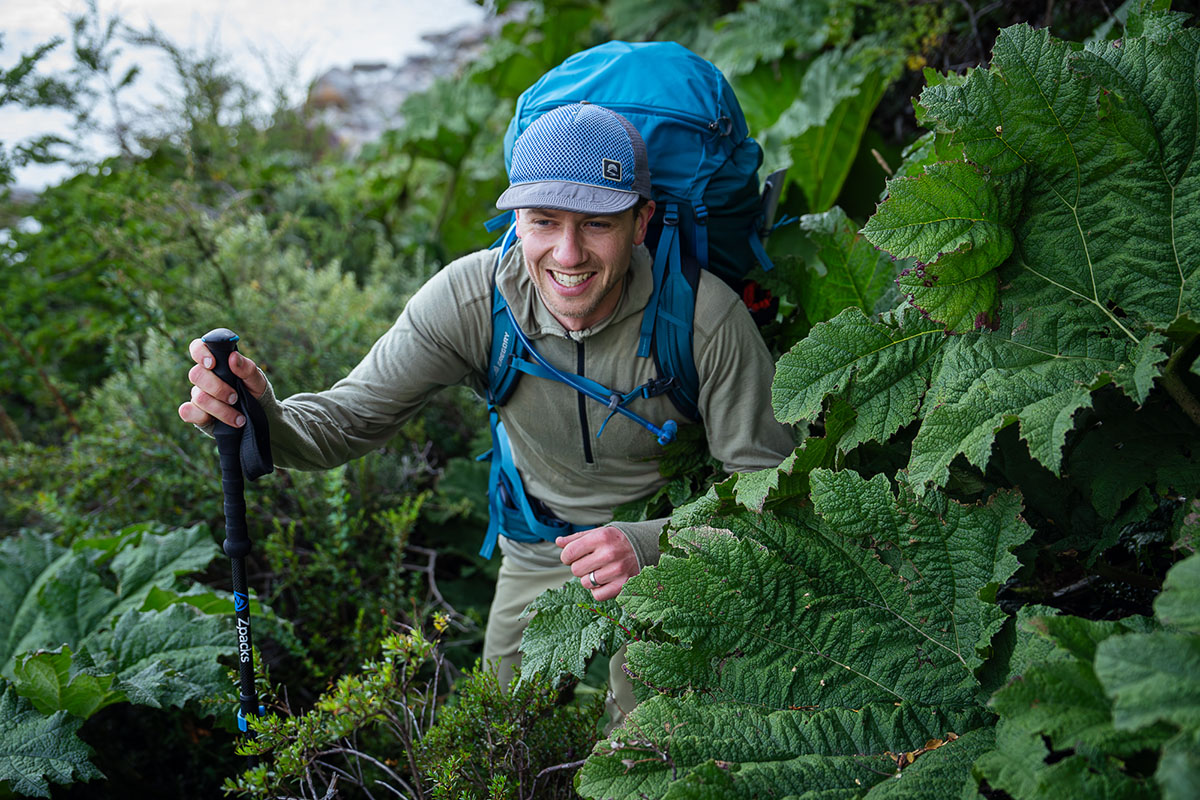
Sun shirts are a fast-growing outdoor trend, and rightfully so—covering up can go a long way toward eliminating sunburns and guarding against the exhaustion of all-day exposure. They’re especially nice to have for activities that include a solar reflector, such as fishing and boating (water), climbing (rock or snow), and backcountry skiing (snow). At their best, these lightweight long-sleeves do two things well: They offer full upper-body coverage against the sun and keep air flowing with breathable materials. Most designs feature synthetic, UPF-rated fabrics, and all of our picks above include hoods that extend protection to the neck and face. Thanks to their protective and breathable nature, sun shirts—or sun hoodies, as we often call them—have become an essential part of our arsenal for everything from hiking and backpacking to stand up paddle boarding, climbing, and backcountry skiing.
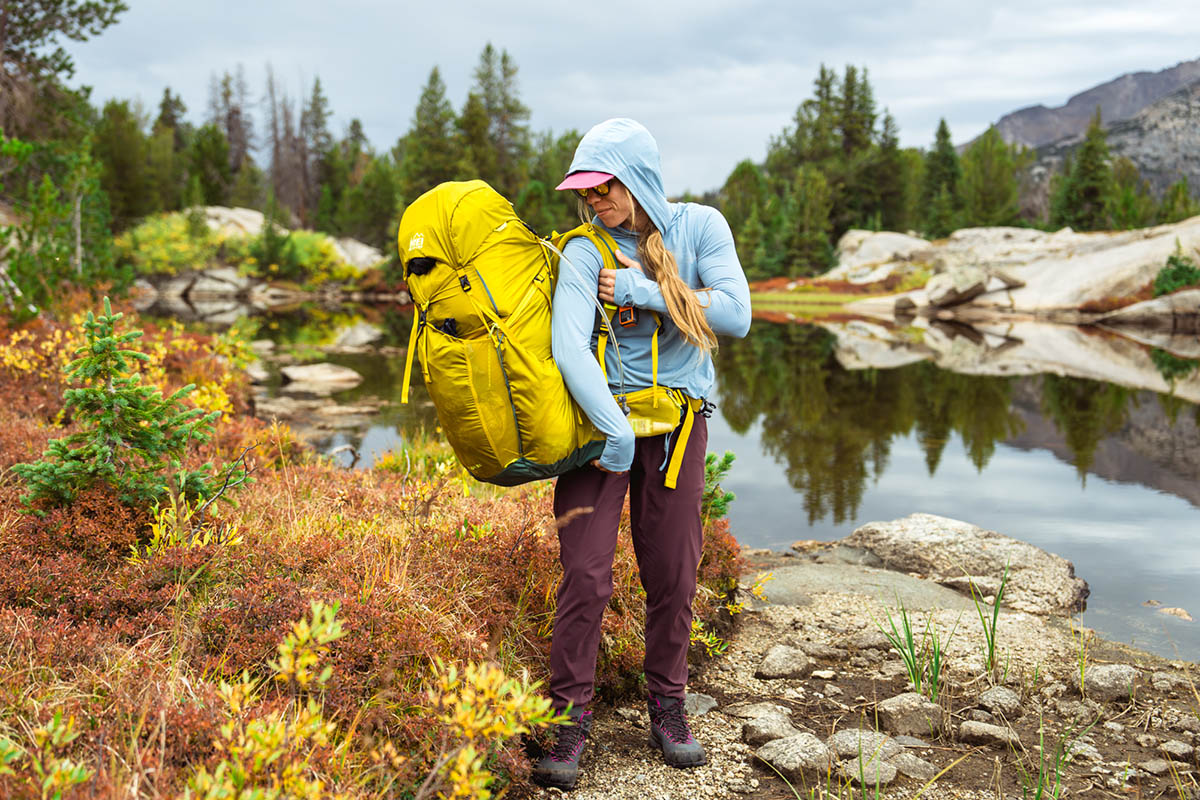
Synthetics
The vast majority of sun shirts are made with polyester, which is breathable, robust enough to keep UV radiation at bay, and maintains impressive abrasion resistance for the thickness. Some shirts, like the climbing-specific Black Diamond Alpenglow Pro and Outdoor Research Astroman Air, use nylon, which is another synthetic that’s generally a bit stiffer and more abrasion-resistant but not as comfortable as polyester. We generally recommend synthetic sun hoodies for warm weather and use around water, but be advised that they are known to hold stink (many now include odor-resistant treatments, which helps a lot). For the best combination of protection and breathability, synthetic sun shirts are our top choice.
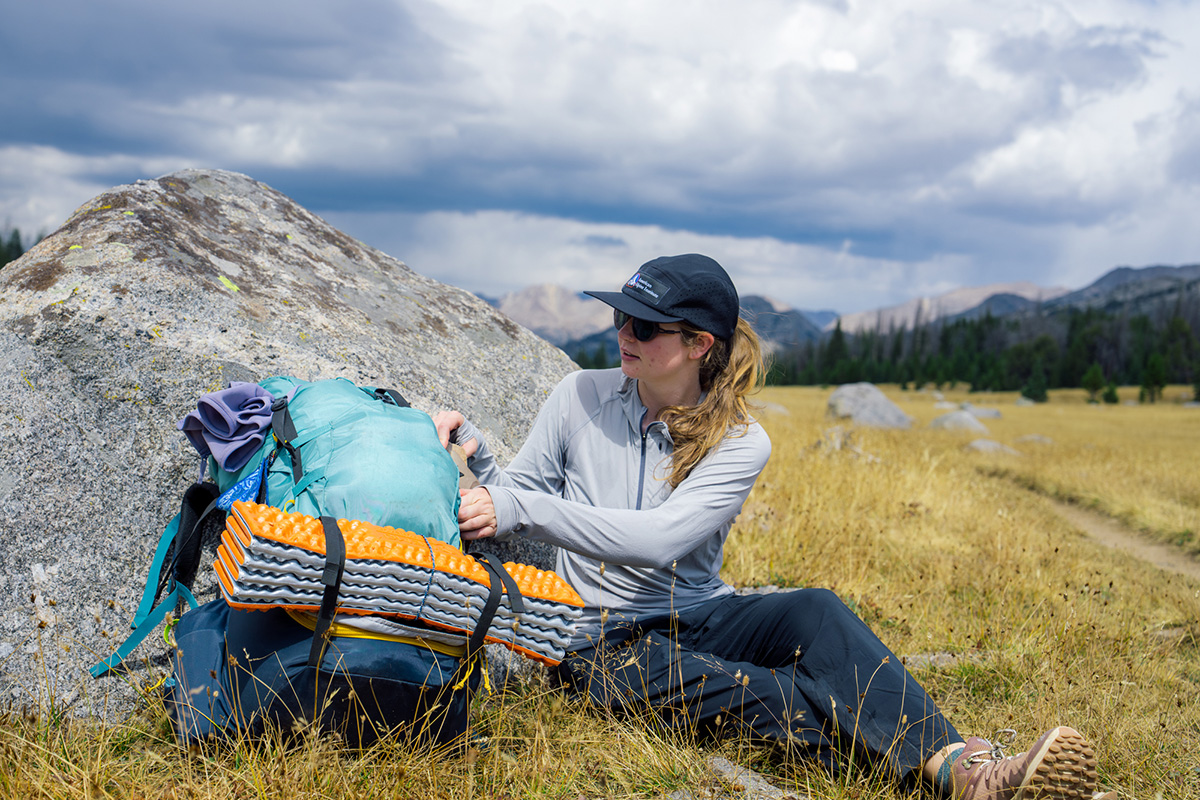
Natural Fibers
A few sun hoodies above use natural fiber blends, including merino wool and bamboo (both are woven with polyester for durability), and Patagonia's modal sun, which is sourced from natural beech tree pulp. These materials offer a soft and cozy feel and resist odor better than synthetics. However, while merino wool is our favorite baselayer material, it’s too insulative for use in a versatile sun shirt. On the other hand, bamboo and modal (like cotton) absorb water and aren’t quick to dry. What’s more, all these materials require extra care when it comes to laundering, and they won’t hold up to heavy use as well as comparable synthetics. There’s a time and place for natural fibers—merino sun shirts can be nice in colder conditions, while bamboo and modal are soft enough for everyday use—but neither offer the versatile performance of synthetic alternatives.
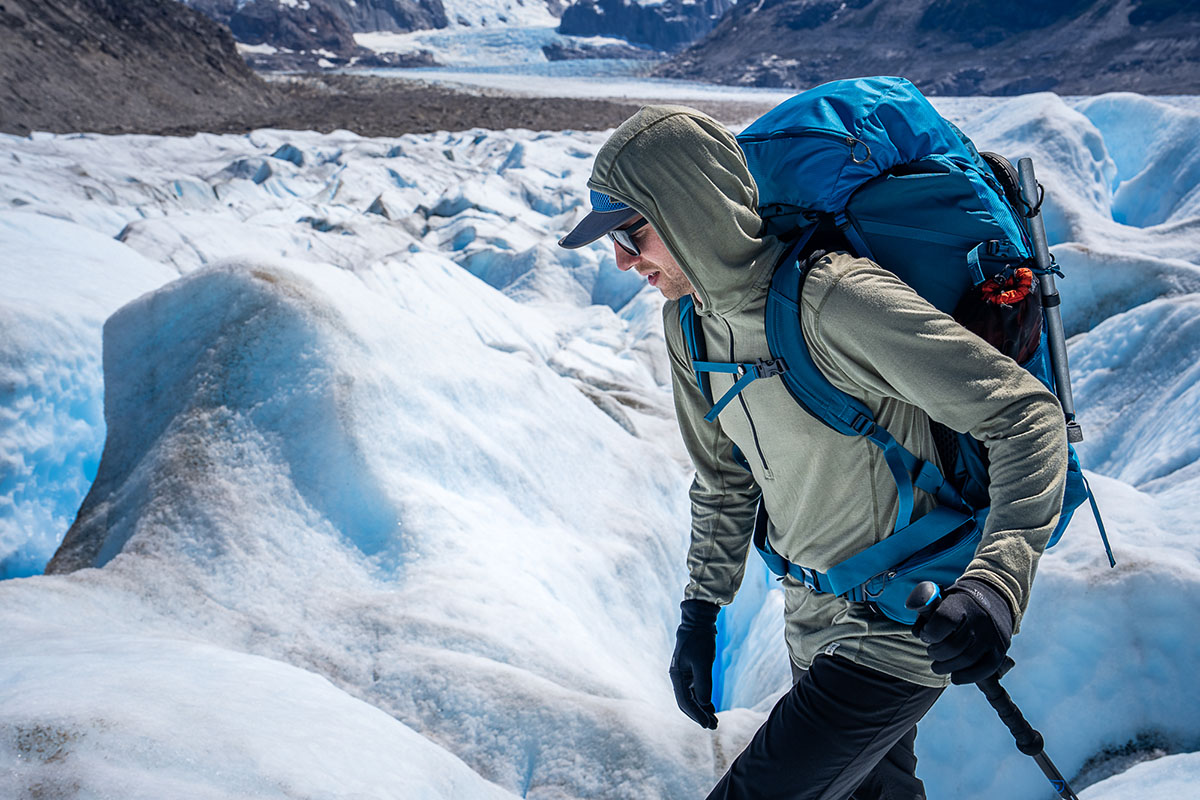
Most sun shirts have a UPF rating, which gives an estimate of how much UV radiation the fabric allows to pass through. A UPF rating of 50 means that just 1/50th (or 2%) of the available UV rays are able to make their way to the other side of the fabric, while a UPF rating of 30 denotes that 1/30th of rays will pass through. For reference, a UPF of 15 is the lowest possible rating, and 50+ is the highest (of note: UPF 30 is the minimum rating that qualifies for the Skin Cancer Foundation’s official recommendation). And of course, if you’re wearing more than one layer, you get more sun protection. We have yet to meet anyone who’s been burned through a sun shirt, but if your priority is maximizing sun protection, it’s worth aiming for the higher numbers.
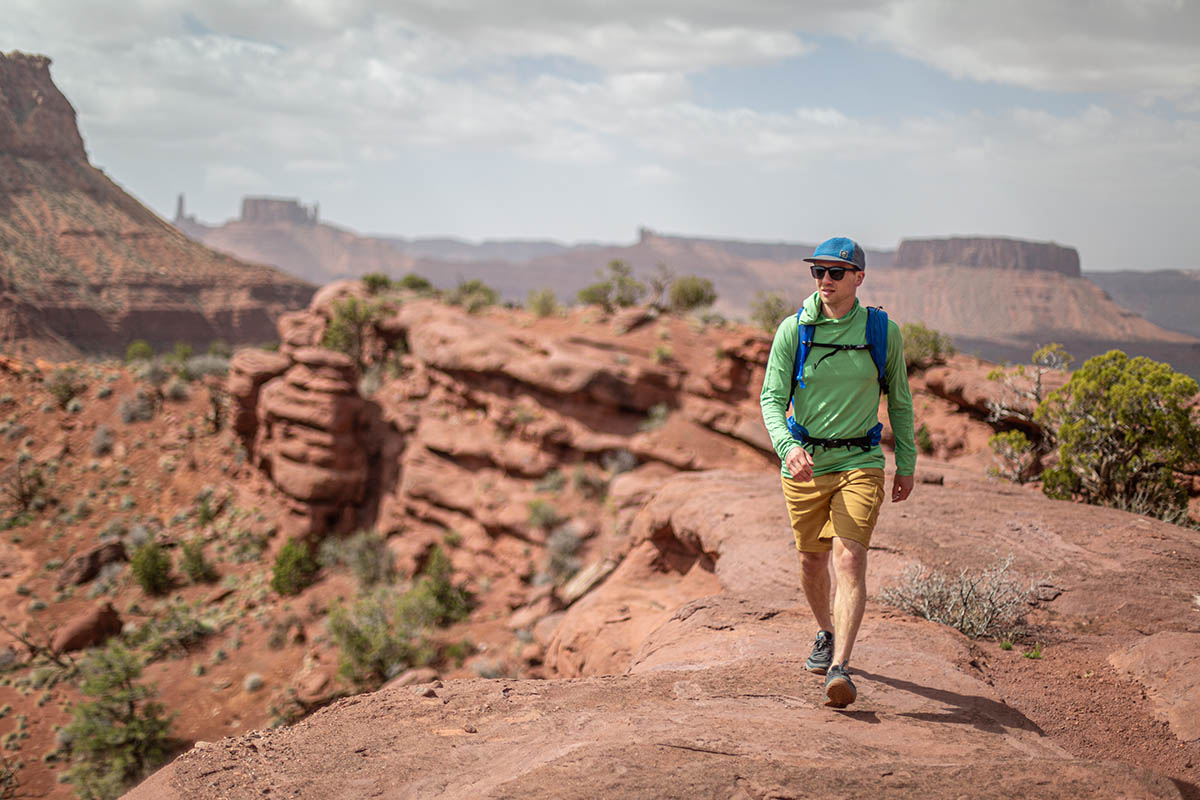
Several factors contribute to a sun shirt’s UPF rating, including the fabric thickness and color, fiber type (polyester and nylon are more effective than wool and cotton), and whether or not the material has been treated with a UV-resistant chemical or dye. In general, darker fabrics offer better sun protection than lighter-colored fabrics (Outdoor Research’s Echo Hoodie gets a 15 UPF rating in the lighter colorways, while the darker options are 20 UPF). And to boost protection, one technique (used by Patagonia) is to apply a titanium dioxide additive to the yarn, similar to the active ingredient in many reef-safe sunscreen products. This allows manufacturers to use lightweight (read: breathable) fabrics while still maximizing UV resistance.
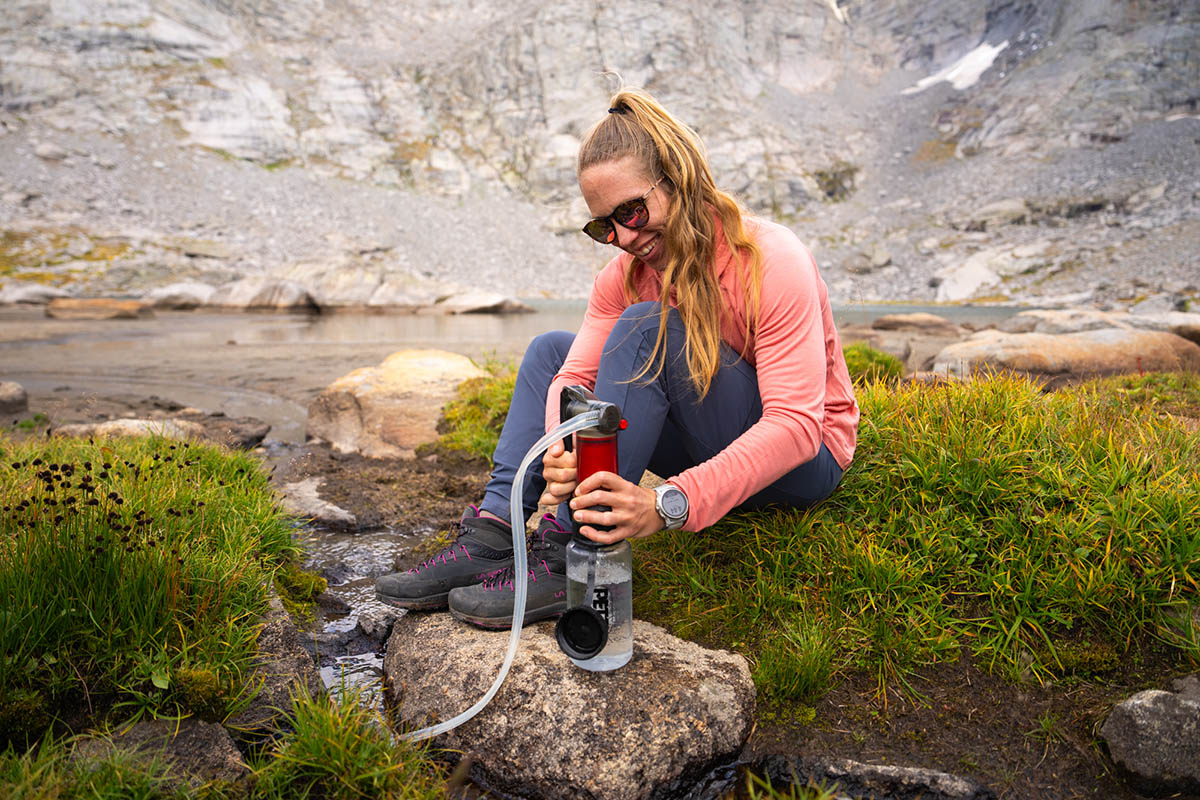
Sun shirts are offered in a variety of colorways, but you’ll want to factor in more than style when making your choice. In general, dark or bright shirts absorb more UV rays and thus offer better protection—again, this is illustrated well by OR’s Echo hoody, which features a lower UPF rating (15) for the lighter colorways and a higher number (20) for the darker versions. That said, in direct sunlight, a darker shirt will be significantly warmer than a white shirt, which might diminish your chances of wearing it on a hot day. Personally, we’re a big fan of light-colored sun shirts as they provide a functional mix of protection and comfort, and a tight weave and treated fibers can go a long way toward resisting UV rays.
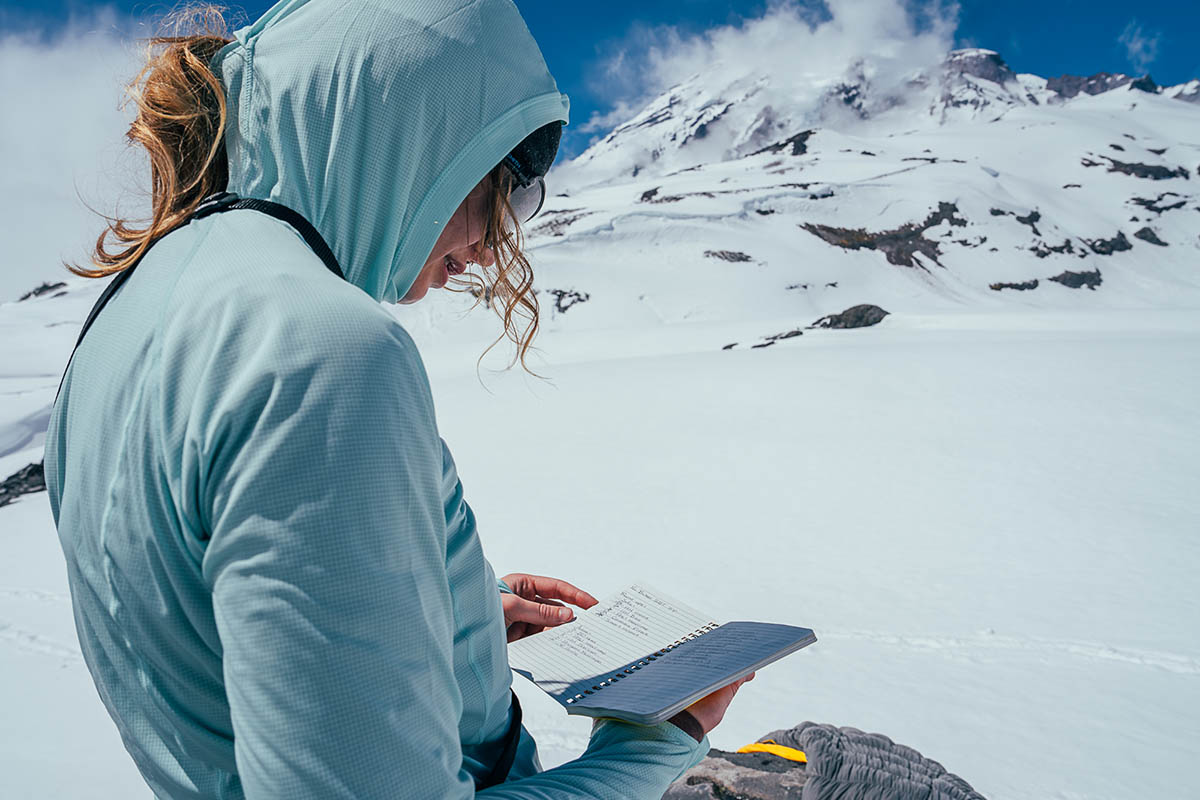
You might not think a hooded long sleeve shirt would be very comfortable to wear on a warm and sunny day, but think again. Thanks to their UV-resistant and breathable fabrics, sun shirts can shade your skin and actually keep you cooler than a t-shirt or tank top, even (or especially) in hot temperatures. Thin synthetics are among the most breathable, while merino wool or thicker synthetic shirts have a greater tendency to trap your body’s heat. And some shirts even incorporate vents: The Alpenglow Pro features underarm mesh, the Outdoor Research Astroman Air has tiny perforations along the sides, and quarter-zip or buttoned designs like the Jolly Gear Triple Crown Button Down give you the ability to dump heat at the chest (you’ll want to be careful, as opening a vent could expose some skin to the sun).
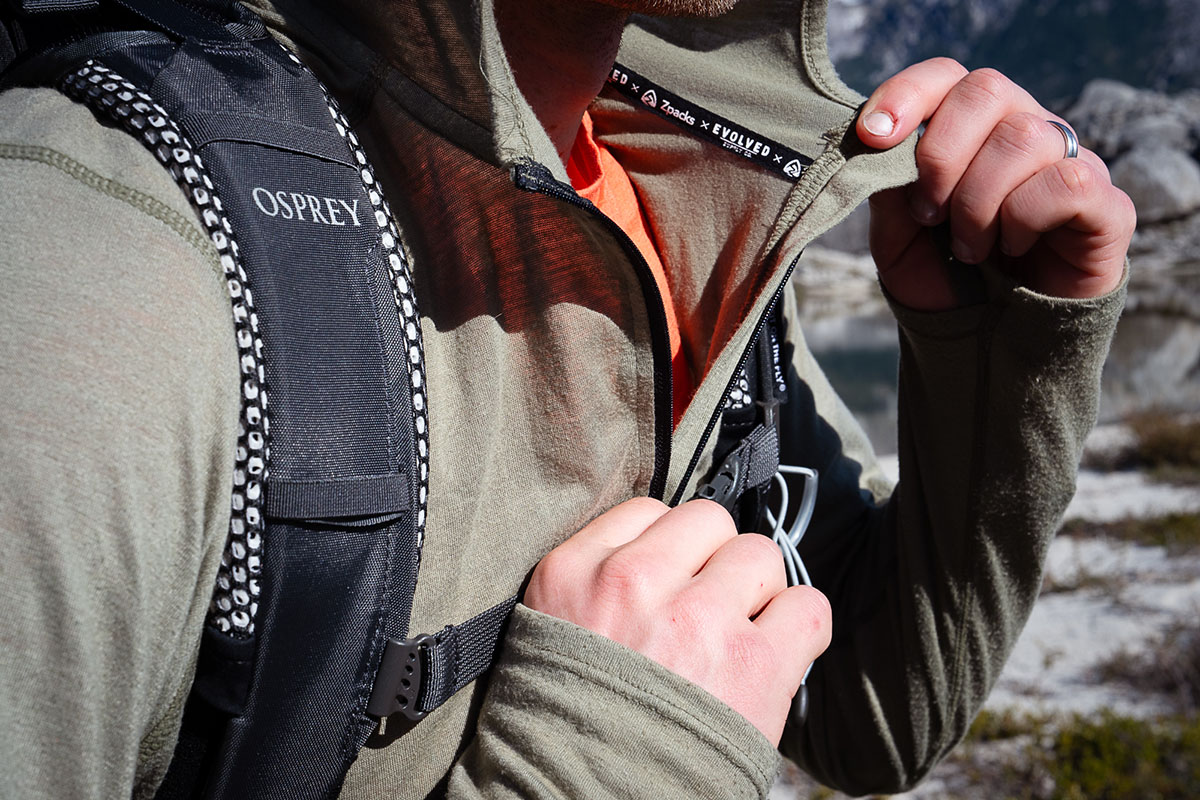
Most sun shirts offer ample breathability for activities like fishing, low-output hiking, rock climbing, and backcountry skiing. However, sun shirts are not popular among runners, and for good reason: There’s simply too much fabric when you’re really building up a sweat. Running-specific brands like Rabbit and Janji have a handful of purpose-built options, including the UPF Deflector Zip and Sunchaser 50, but we often prefer to just re-apply sunscreen on our upper body as needed. If you do opt to wear a sun hoody while running, we’ve found it helpful to douse the hoody in trailside streams and wear it wet, creating a lovely swamp cooler effect.
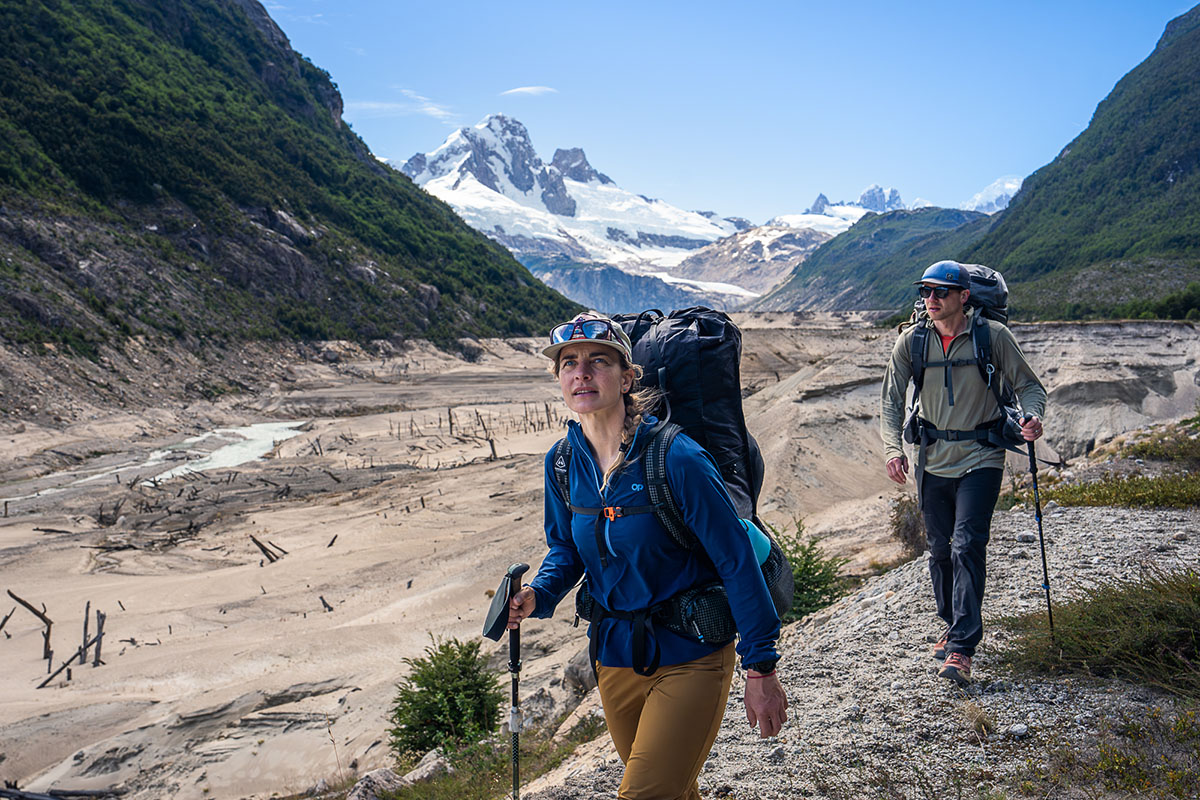
Sun shirts don’t often check in heavier than 10 ounces, but the slight variations in weight can tell us a lot about each particular design. One of the lightest sun shirts here is the Outdoor Research Echo (5.2 oz.), which is also the thinnest and most breathable choice for hot-weather and high-output activities. At the other end of the spectrum is the 8.7-ounce Ridge Merino Solstice, which is one of the heaviest on our list and also our top cold-weather pick. It doesn’t take much of a mathematician to discern that a heavier sun shirt is generally warmer and more insulated. We’ve referenced warmth a great deal in the write-ups above, but the weight can still be a helpful hint for those purchasing online.
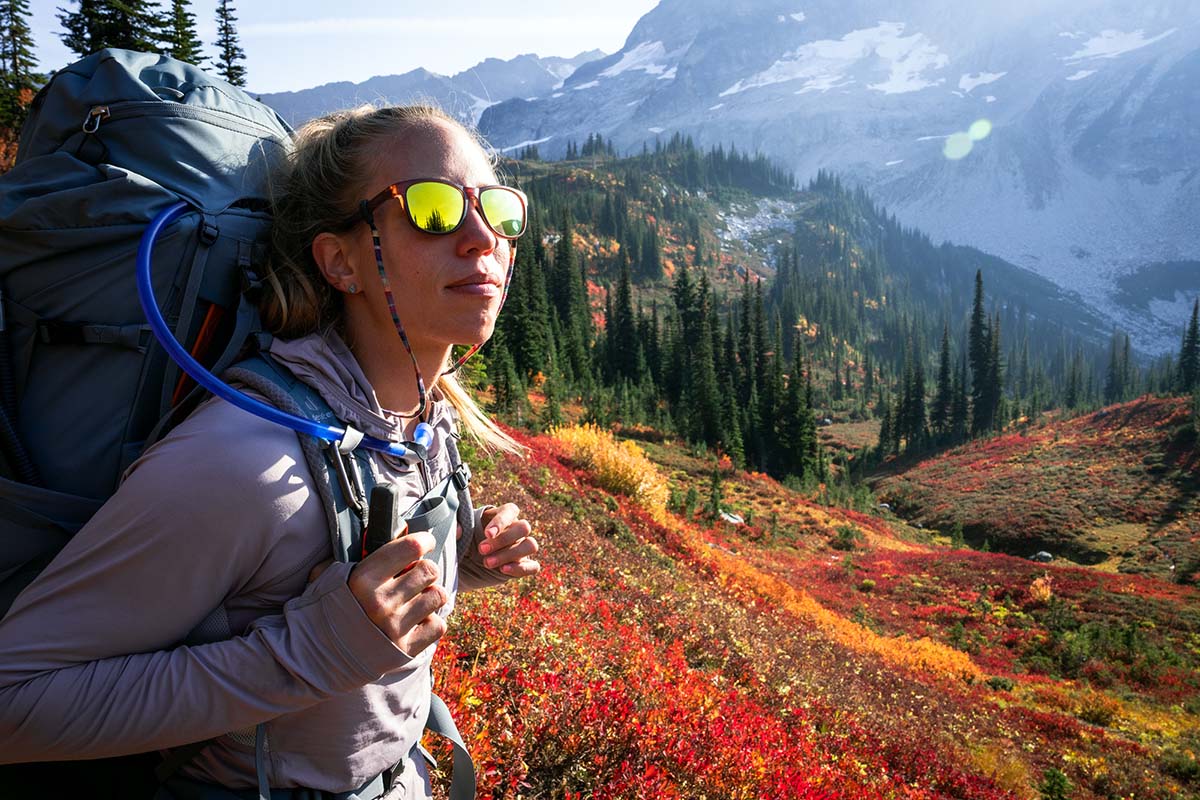
Another spec to look at is the shirt’s fabric weight, generally given in grams per square meter (g/m2, or gsm) or ounce per square yard. For example, the Rab Force uses 105-gram polyester, while the Ridge Merino features a 145-gram merino throughout. Keep in mind that not every shirt specifies a fabric weight, nor does it perfectly align with warmth due to variations in fit and material (1g merino wool generally offers more warmth than 1g polyester or 1g bamboo). That said, if you can find the fabric weight, it’s an even more accurate way (compared to total weight) to determine a shirt’s overall warmth.
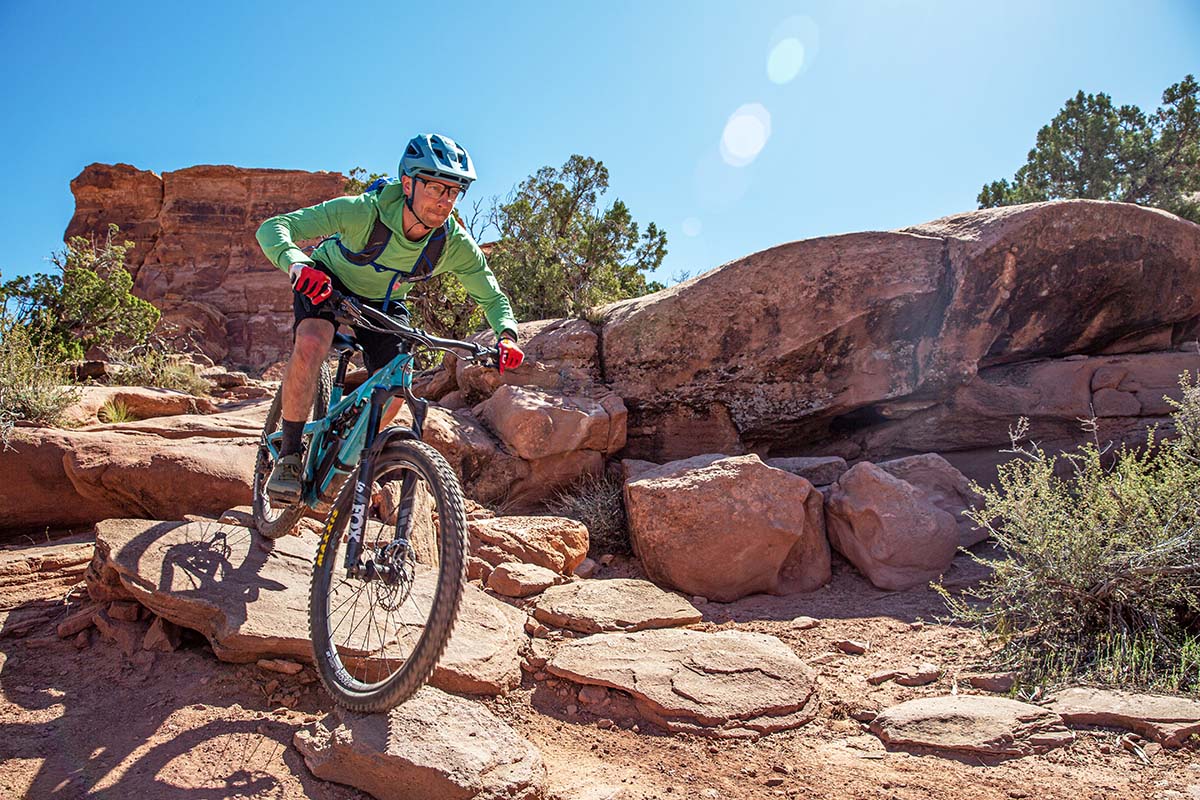
You may have noticed that our list above includes exclusively hooded sun shirts, which hints at how we feel about non-hooded designs. For performance use, there’s simply no better option for complete sun coverage, especially when it comes to protecting your neck and face. Many of the designs above are also offered in non-hooded versions, which are suitable if you plan to wear a wide-brimmed hat or buff.
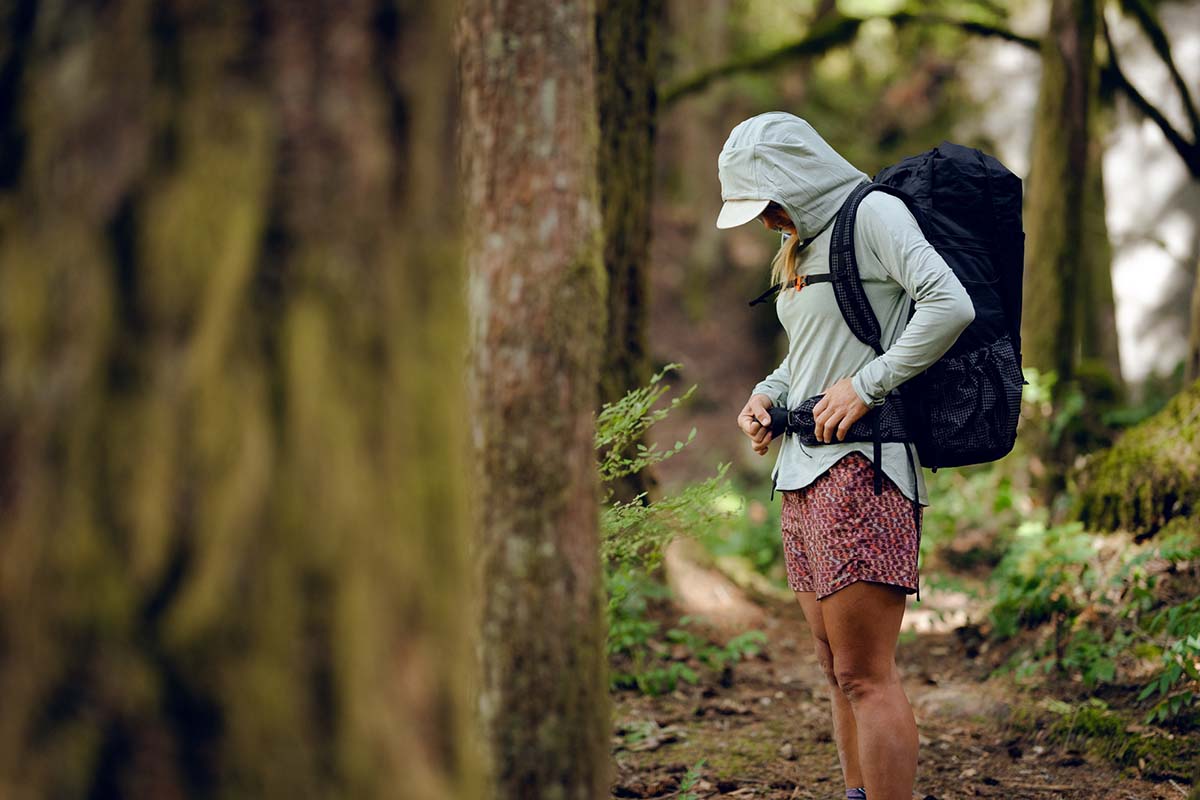
There are a few factors worth considering when looking at hoods. Size is the first: You’ll want to think about whether or not you want to wear the hood over your bare head, a ball cap, or a climbing helmet. Further, some hoods incorporate a drawcord, which can be a nice feature in the wind, although we rarely find ourselves using it. If you opt for this style, we’d recommend a sleek system like that on the REI Co-op Sahara Shade Hoodie or Jolly Gear Triple Crown over a design with a long drawcord (like the Ridge Merino). These can get in the way, especially when climbing, and are largely impractical. A hat can be an excellent way to tame an unruly hood—not only does it keep it off your face, but it also provides friction to secure it in place in the wind or while hiking briskly.
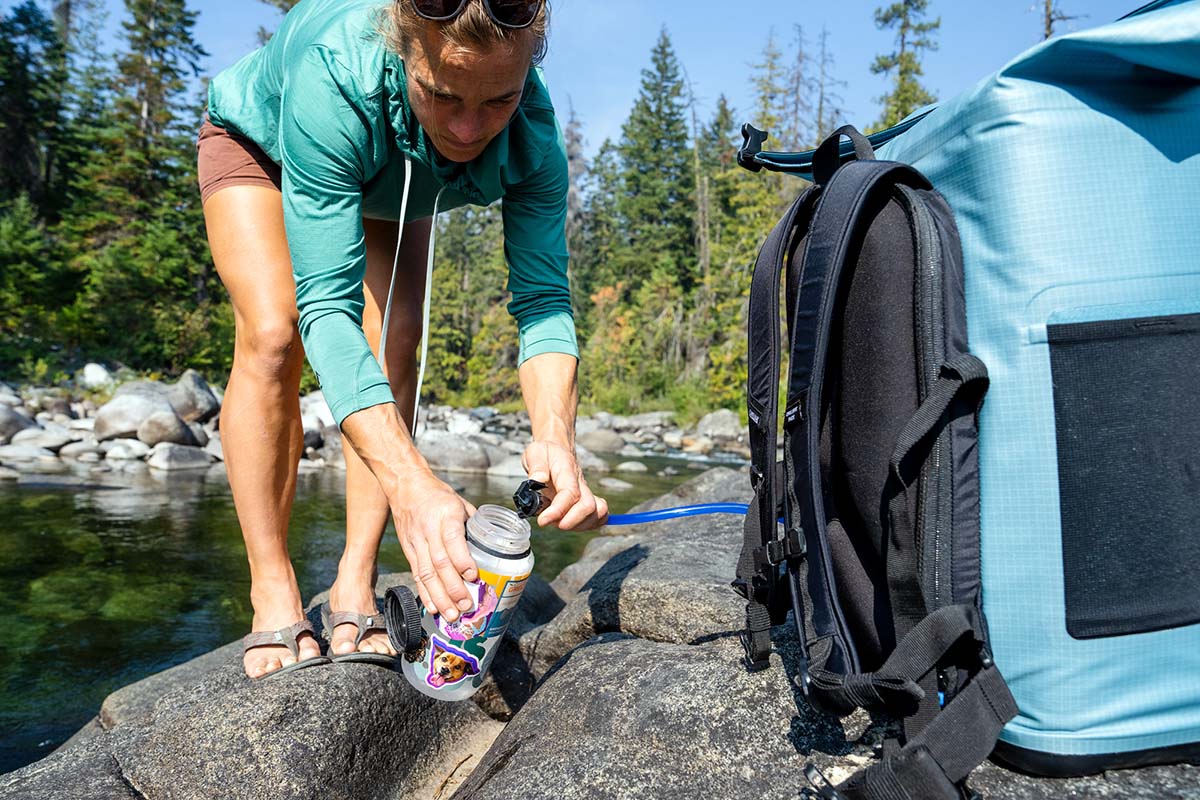
Sun shirts are incredibly simple pieces of gear, but there are a few features to keep in mind when picking the best fit for your needs. First off, many people will appreciate the added security and coverage of thumbholes or loops, which keep the shirt from riding up and exposing the area between your glove and shirt. Given that the wrists are often forgotten when applying sunscreen, this can be a nice place to maintain coverage, especially for bikers. Second, some sun shirts have small zippered pockets, which may or may not prove to be helpful. These pockets are often placed at the hip, making them difficult to access when wearing a backpack or climbing harness. Finally, we sometimes see hood or waist cinches (the women's version of the Mountain Hardwear Crater Lake Hoody is one example), which might earn you style points but aren’t particularly practical (in our opinion). You’ll likely want to keep your shirt uncinched to encourage ventilation and keep the hood flared out for maximum coverage.
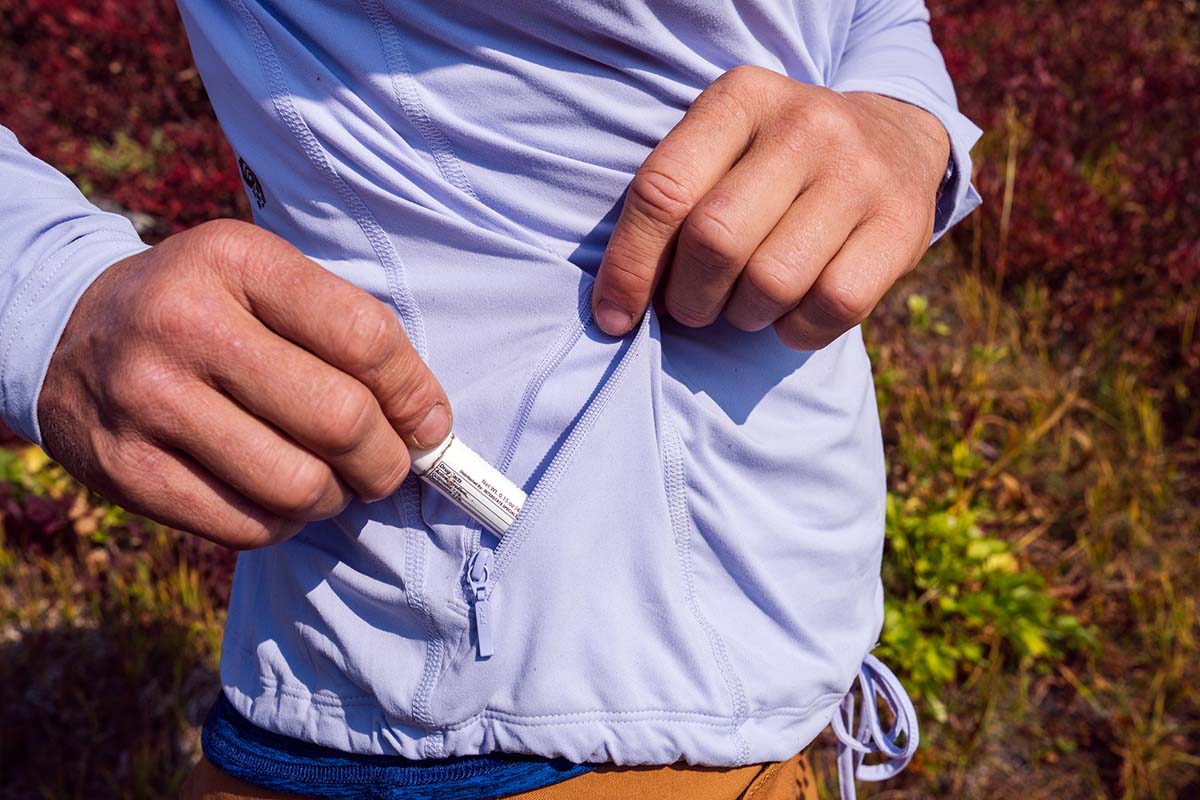
There are a few features that we see particularly in climbing-centric designs like the BD Alpenglow Pro and Outdoor Research Astroman Air. Both of these sun shirts have a deep zip at the neck, which is invaluable for getting the shirt on and off over a helmet. They also each feature a large, phone-sized chest pocket (especially helpful if you're climbing sans backpack) and targeted ventilation in the form of perforated or mesh underarm panels. And the Astroman goes one step further with elastic cuffs at the wrists, which are great for keeping the sleeves out of your way while climbing.
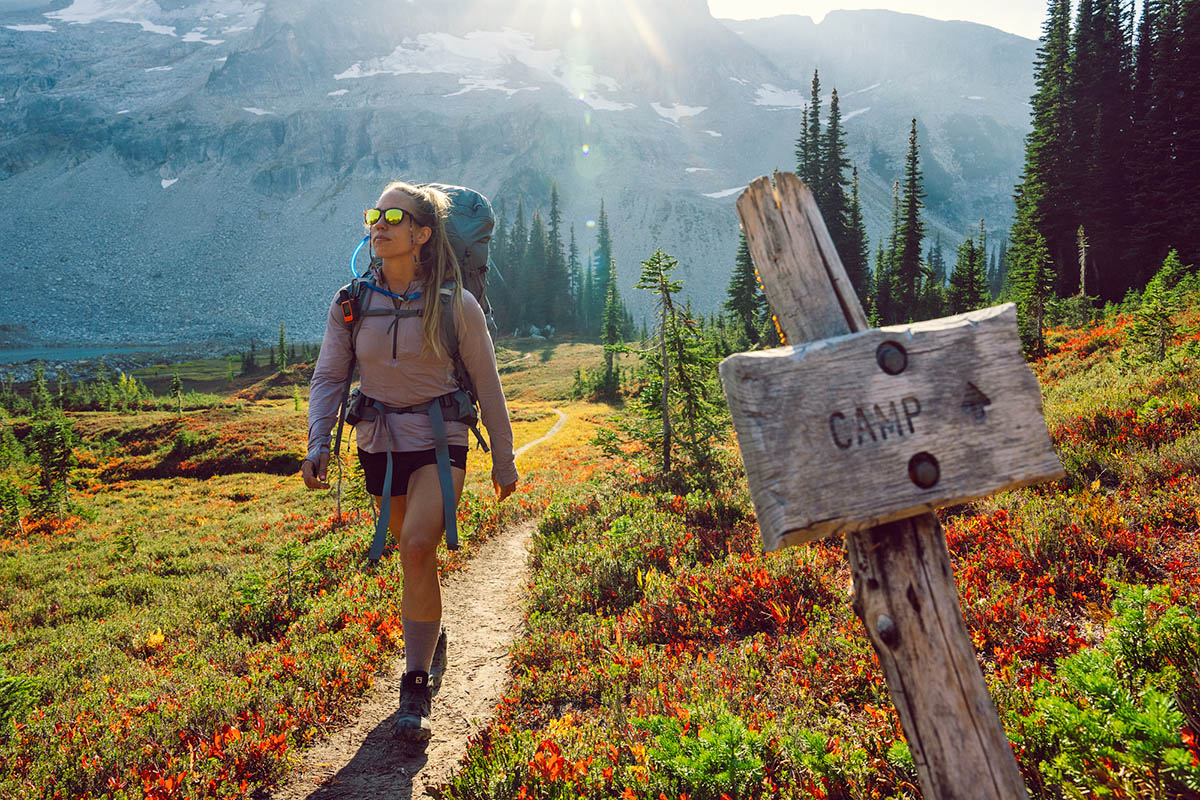
Synthetic fabrics are known to build stink, which isn’t a great characteristic when sweat is practically a given. To help keep B.O. at bay, most modern synthetic sun shirts incorporate some sort of anti-odor treatment—Patagonia uses a technology called HeiQ Pure on their Capilene Cool Daily Hoody, for example, while Outdoor Research’s Echo features their ActiveFresh tech. Surprisingly, these technologies generally work quite well, which is good news for everyone. And it’s worth noting that natural fibers are generally naturally odor-resistant, including the merino/bamboo constructions of the Ridge Merino Solstice Lightweight Hoody, Zpacks The Mirage Merino Sun Hoody, and Free Fly Bamboo Lightweight Hoodie.
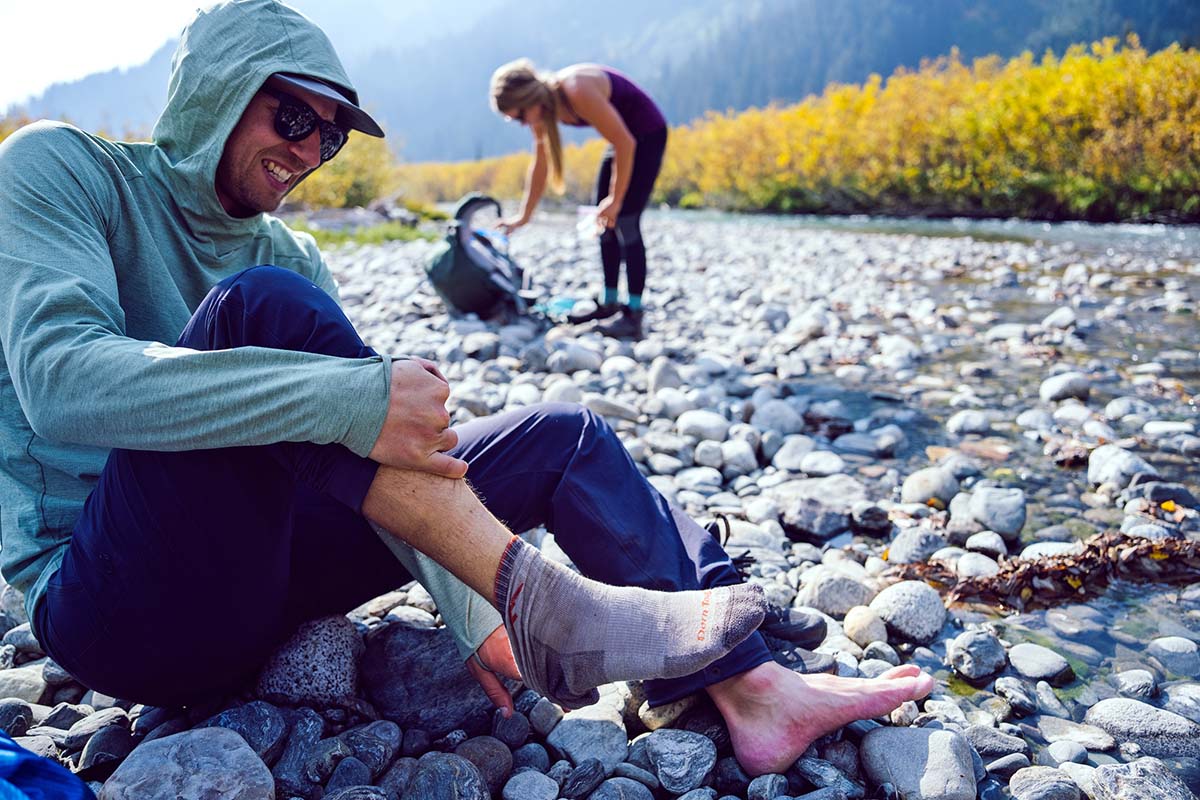
Sun shirts can vary a great deal in terms of durability: Some are built to handle the rigors of rock climbing, while others are so thin they’re liable to ripping and snagging. Nylon is particularly hardwearing—seen in climbing-specific designs like the Black Diamond Alpenglow Pro and Outdoor Research Astroman Air—and polyester is next in line. Merino wool, on the other hand, will not hold up well to sustained wear and tear. Natural fibers like bamboo and modal are somewhere in the middle, and when blended with a bit of polyester or spandex, we've found them to be fully sufficient for activities like hiking and backpacking. Finally, thicker fabrics generally offer better tear resistance than thinner designs, although fabrics of any weight can be prone to pilling and snagging. To help guide your purchase, we’ve made sure to note durability strengths and weaknesses in the write-ups above.
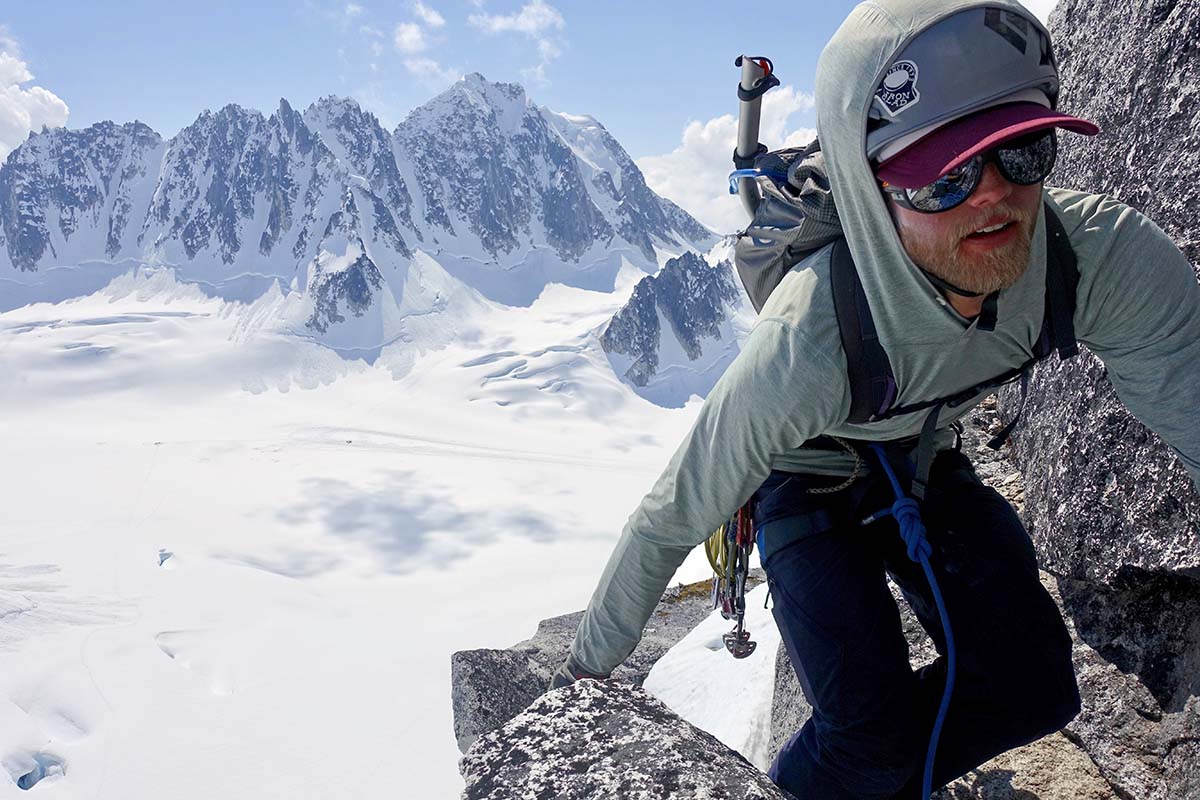
In general, sun shirts are built to provide a relaxed fit that maximizes airflow and freedom of movement. When dialing in sizing, pay attention to the shape and fit of the shirt at the neck, as you’ll want to make sure you get ample coverage where it counts. Depending on the fabric, some shirts will fit snugger than others: The Mountain Hardwear Crater Lake, for example, is fairly snug, while the Ridge Merino Solstice is very roomy. All told, fit comes down to personal preference, although we lean towards recommending looser-fitting fabrics for the added airflow. Sun shirts are also not meant to be layered over much more than a thin t-shirt or tank top (we generally wear ours next to skin), so be sure to size accordingly.
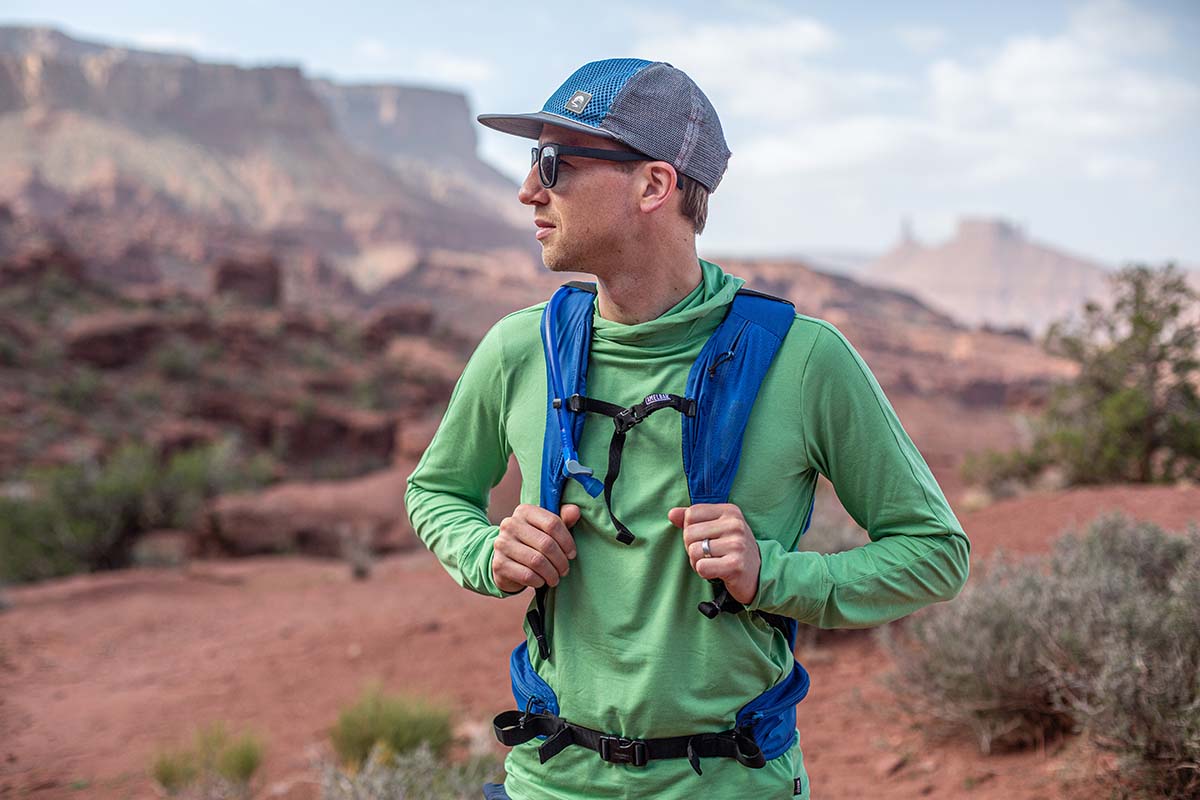
In 2025, one of the primary ways we see manufacturers innovating is through the use of more sustainable materials. In terms of sun shirts, this means the use of recycled and/or natural fabrics (like modal, bamboo, and merino), more responsible production practices (including the elimination of harmful chemicals used in UV-resistant treatments), and an emphasis on the ethical treatment of workers, often denoted by a Fair Trade certification. Many companies also utilize the bluesign system for sourcing materials responsibly. Patagonia is a clear leader in the sustainability movement, but brands like Outdoor Research, REI, Arc’teryx, and Black Diamond have also made a sizable effort to reduce their footprint. And while we encourage you to shop sustainably, we’re also big advocates of lowering consumption by reusing old gear. Many brands offer repair programs and used marketplaces for their offerings, and gear consignment stores can be treasure troves for like-new items.
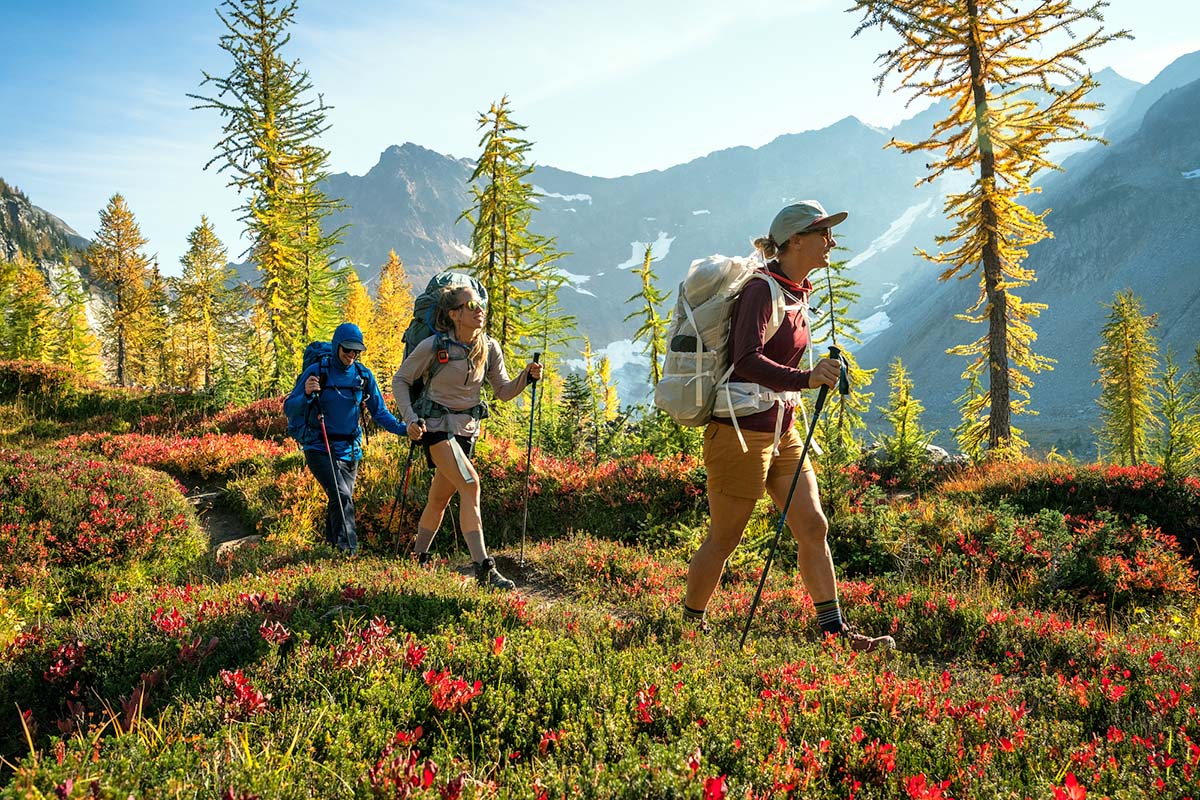
In addition to the hoodies here, there are a variety of designs that could also fit into the “sun shirt” category, including crew-neck synthetics and UV-resistant button-ups. For example, REI Co-op's Sahara collection, which includes the Sahara Shade Hoodie above, also features several long-sleeve and button-down options, as well as t-shirts for men and women, plus a women's-specific tank top. While there’s a time and place for these alternatives—and a UPF-rated top is never a bad idea—none offer the same level of neck and head coverage as a sun hoodie. In other words, there’s no substitute for the picks above when it comes to all-out protection.
Back to Our Top Sun Shirt Picks Back to Our Sun Shirt Comparison Table